Emerging Thermal Detectors Based on Low-Dimensional Materials: Strategies and Progress
Abstract
1. Introduction
2. Principles and Parameters for Thermal Detector
2.1. Principles of Thermal Detector
2.2. Parameters of Thermal Detector
2.2.1. Responsivity
2.2.2. Response Speed at 3 dB Working Bandwidth
2.2.3. External Quantum Efficiency
2.2.4. Noise Equivalent Power
2.2.5. Specific Detectivity
2.2.6. Figure-of-Merit for Thermal Detectors
3. Research Progress on TDLMs
3.1. Photothermal Enhancement Strategies
3.1.1. Optical Structure Design
3.1.2. Composite Engineering
3.2. Thermoelectric Enhancement Strategies
3.2.1. Thermoelectric Coefficient Manipulation
3.2.2. Thermal Management Design
3.2.3. Intrinsic Material Properties Enhancement
3.2.4. Synergistic Mechanism Engineering
4. Representative Application of TDLMs
4.1. Optical Communication
4.2. Polarization Encryption Imaging
4.3. Flexible Sensing
5. Perspective and Outlook
Author Contributions
Funding
Conflicts of Interest
References
- Wu, W.F.; Ma, H.; Cai, X.; Han, B.; Li, Y.; Xu, K.; Lin, H.T.; Zhang, F.; Chen, Z.Y.; Zhang, Z.Y.; et al. High-Speed Carbon Nanotube Photodetectors for 2 μm Communications. ACS Nano 2023, 17, 15155–15164. [Google Scholar] [CrossRef]
- Zhu, Y.; Chen, H.; Han, R.; Qin, H.; Yao, Z.; Liu, H.; Ma, Y.; Wan, X.; Li, G.; Chen, Y. High-speed flexible near-infrared organic photodiode for optical communication. Natl. Sci. Rev. 2024, 11, nwad311. [Google Scholar] [CrossRef]
- Fu, J.T.; Nie, C.B.; Sun, F.Y.; Jiang, H.; Li, Y.J.; Li, G.L.; Wei, X.Z. Photo-Driven Semimetal-Semiconductor Field-Effect Transistors. Adv. Opt. Mater. 2023, 11, 2201983. [Google Scholar] [CrossRef]
- Fu, J.T.; Ji, L.; Wu, Z.C.; Li, G.L.; Nie, C.B.; Xiong, W.; Wang, F.; Sun, F.Y.; Zhou, Y.C.; Zang, Z.G.; et al. An all-in-one optoelectronic logic device with self-distinguishable dual-band photoresponse. Device 2024, 2, 100321. [Google Scholar] [CrossRef]
- Yang, C.; Feng, S.L.; Tang, L.L.; Shen, J.; Wei, X.Z.; Shi, H.F. Electrochemical Epitaxial Grown PbS Nanorods Array on Graphene Film for High-Performance Photodetector. Adv. Mater. Interfaces 2021, 8, 2001464. [Google Scholar] [CrossRef]
- Wu, D.; Guo, C.G.; Zeng, L.H.; Ren, X.Y.; Shi, Z.F.; Wen, L.; Chen, Q.; Zhang, M.; Li, X.J.; Shan, C.X.; et al. Phase-controlled van der Waals growth of wafer-scale 2D MoTe2 layers for integrated high-sensitivity broadband infrared photodetection. Light Sci. Appl. 2023, 12, 5. [Google Scholar] [CrossRef]
- Zeng, L.H.; Han, W.; Ren, X.Y.; Li, X.; Wu, D.; Liu, S.J.; Wang, H.; Lau, S.P.; Tsang, Y.H.; Shan, C.X.; et al. Uncooled Mid-Infrared Sensing Enabled by Chip-Integrated Low-Temperature-Grown 2D PdTe2 Dirac Semimetal. Nano Lett. 2023, 23, 8241–8248. [Google Scholar] [CrossRef] [PubMed]
- Wu, D.; Mo, Z.H.; Li, X.; Ren, X.Y.; Shi, Z.F.; Li, X.J.; Zhang, L.; Yu, X.C.; Peng, H.X.; Zeng, L.H.; et al. Integrated mid-infrared sensing and ultrashort lasers based on wafer-level Td-WTe2 Weyl semimetal. Appl. Phys. Rev. 2024, 11, 041401. [Google Scholar] [CrossRef]
- Li, Z.A.; Si, G.S.; Ning, Z.Q.; Liu, J.X.; Fang, Y.H.; Si, B.B.; Cheng, Z.; Yang, C.P. Highly Sensitive Sphere-Tube Coupled Photoacoustic Cell Suitable for Detection of a Variety of Trace Gases: NO2 as an Example. Sensors 2022, 22, 281. [Google Scholar] [CrossRef]
- Wang, F.K.; Zhu, S.; Chen, W.D.; Han, J.Y.; Duan, R.H.; Wang, C.W.; Dai, M.J.; Sun, F.Y.; Jin, Y.H.; Wang, Q.J. Multidimensional detection enabled by twisted black arsenic-phosphorus homojunctions. Nat. Nanotechnol. 2024, 19, 455–462. [Google Scholar] [CrossRef]
- Zhang, S.K.; Jiao, H.X.; Chen, Y.; Yin, R.T.; Huang, X.N.; Zhao, Q.R.; Tan, C.; Huang, S.Y.; Yan, H.G.; Lin, T.; et al. Multi-dimensional optical information acquisition based on a misaligned unipolar barrier photodetector. Nat. Commun. 2024, 15, 7071. [Google Scholar] [CrossRef] [PubMed]
- Zeng, L.H.; Wu, D.; Jie, J.S.; Ren, X.Y.; Hu, X.; Lau, S.P.; Chai, Y.; Tsang, Y.H. Van der Waals Epitaxial Growth of Mosaic-Like 2D Platinum Ditelluride Layers for Room-Temperature Mid-Infrared Photodetection up to 10.6 μm. Adv. Mater. 2020, 32, 2004412. [Google Scholar] [CrossRef]
- Wu, P.S.; Ye, L.; Tong, L.; Wang, P.; Wang, Y.; Wang, H.L.; Ge, H.N.; Wang, Z.; Gu, Y.; Zhang, K.; et al. Van der Waals two-color infrared photodetector. Light Sci. Appl. 2022, 11, 6. [Google Scholar] [CrossRef] [PubMed]
- Zhou, Y.; Qiu, X.; Wan, Z.A.; Long, Z.H.; Poddar, S.; Zhang, Q.P.; Ding, Y.C.; Chan, C.L.J.; Zhang, D.Q.; Zhou, K.M.; et al. Halide-exchanged perovskite photodetectors for wearable visible-blind ultraviolet monitoring. Nano Energy 2022, 100, 107516. [Google Scholar] [CrossRef]
- Lee, K.; Cho, I.; Kang, M.G.; Jeong, J.; Choi, M.; Woo, K.Y.; Yoon, K.; Cho, Y.; Park, I. Ultra-Low-Power E-Nose System Based on Multi-Micro-LED-Integrated, Nanostructured Gas Sensors and Deep Learning. Acs Nano 2023, 17, 539–551. [Google Scholar] [CrossRef]
- Wei, S.Y.; Li, Z.; Murugappan, K.; Li, Z.Y.; Zhang, F.L.; Saraswathyvilasam, A.G.; Lysevych, M.; Tan, H.H.; Jagadish, C.; Tricoli, A.; et al. A Self-Powered Portable Nanowire Array Gas Sensor for Dynamic NO2 Monitoring at Room Temperature. Adv. Mater. 2023, 35, 2207199. [Google Scholar] [CrossRef]
- Yu, J.; Zheng, J.; Chen, H.Y.; Tian, N.; Li, L.; Qu, Y.M.; Huang, Y.T.; Luo, Y.X.; Tan, W.Z. Near-infrared photodetectors based on CH3NH3PbI3 perovskite single crystals for bioimaging applications. J. Mater. Chem. C 2021, 10, 274–280. [Google Scholar] [CrossRef]
- He, Y.M.; Hu, Y.X.; Peng, M.; Fu, L.C.; Gao, E.R.; Liu, Z.Y.; Dong, C.; Li, S.; Ge, C.Y.; Yuan, C.; et al. One-Dimensional Crystal-Structure Te-Se Alloy for Flexible Shortwave Infrared Photodetector and Imaging. Nano Lett. 2024, 24, 5774–5782. [Google Scholar] [CrossRef]
- Hu, W.D.; Ye, Z.H.; Liao, L.; Chen, H.L.; Chen, L.; Ding, R.J.; He, L.; Chen, X.S.; Lu, W. 128 x 128 long-wavelength/mid-wavelength two-color HgCdTe infrared focal plane array detector with ultralow spectral cross talk. Opt. Lett. 2014, 39, 5184–5187. [Google Scholar] [CrossRef]
- Peng, S.L.; Zhang, C.Y.; Wei, Y.C.; Ouyang, Y.; Han, J.Y.; Li, C.Y.; Dong, M.D.; Wang, J. High performance self-powered PbSe/WSe2 p-n heterojunction photodetector for image sensing. J. Mater. Sci. Technol. 2025, 225, 125–132. [Google Scholar] [CrossRef]
- Wang, T.; Zheng, D.M.; Vegso, K.; Mrkyvkova, N.; Siffalovic, P.; Yuan, X.C.; Somekh, M.G.; Coolen, L.; Pauporte, T.; Fu, F. Flexible array of high performance and stable formamidinium-based low-n 2D halide perovskite photodetectors for optical imaging. Nano Energy 2023, 116, 108827. [Google Scholar] [CrossRef]
- Zhuang, R.Z.; Cai, S.H.; Mei, Z.X.; Liang, H.L.; Zhao, N.J.; Mu, H.R.; Yu, W.Z.; Jiang, Y.; Yuan, J.; Lau, S.P.; et al. Solution-grown BiI/BiI3 van der Waals heterostructures for sensitive X-ray detection. Nat. Commun. 2023, 14, 1621. [Google Scholar] [CrossRef]
- Han, J.Y.; Deng, W.J.; Hu, F.C.; Han, S.; Wang, Z.; Fu, Z.Y.; Zhou, H.X.; Yu, H.; Gou, J.; Wang, J. 2D Materials-Based Photodetectors with Bi-Directional Responses in Enabling Intelligent Optical Sensing. Adv. Funct. Mater. 2025, 2423360. [Google Scholar] [CrossRef]
- Zeng, L.H.; Wu, D.; Lin, S.H.; Xie, C.; Yuan, H.Y.; Lu, W.; Lau, S.P.; Chai, Y.; Luo, L.B.; Li, Z.J.; et al. Controlled Synthesis of 2D Palladium Diselenide for Sensitive Photodetector Applications. Adv. Funct. Mater. 2019, 29, 1806878. [Google Scholar] [CrossRef]
- Yang, M.; Wang, J.; Han, J.Y.; Ling, J.W.; Ji, C.H.; Kong, X.; Liu, X.C.; Huang, Z.H.; Gou, J.; Liu, Z.J.; et al. Enhanced Performance of Wideband Room Temperature Photodetector Based on Cd3As2 Thin Film/Pentacene Heterojunction. ACS Photonics 2018, 5, 3438–3445. [Google Scholar] [CrossRef]
- Jiang, H.; Wei, J.X.; Sun, F.Y.; Nie, C.B.; Fu, J.T.; Shi, H.F.; Sun, J.X.; Wei, X.Z.; Qiu, C.W. Enhanced Photogating Effect in Graphene Photodetectors via Potential Fluctuation Engineering. ACS Nano 2022, 16, 4458–4466. [Google Scholar] [CrossRef] [PubMed]
- Han, J.Y.; Wang, J.; Yang, M.; Kong, X.; Chen, X.Q.; Huang, Z.H.; Guo, H.; Gou, J.; Tao, S.L.; Liu, Z.J.; et al. Graphene/Organic Semiconductor Heterojunction Phototransistors with Broadband and Bi-directional Photoresponse. Adv. Mater. 2018, 30, 1804020. [Google Scholar] [CrossRef]
- Fu, J.T.; Guo, Z.M.; Nie, C.B.; Sun, F.Y.; Li, G.L.; Feng, S.L.; Wei, X.Z. Schottky infrared detectors with optically tunable barriers beyond the internal photoemission limit. Innovation 2024, 5, 100600. [Google Scholar] [CrossRef]
- Jiang, H.; Wang, M.; Fu, J.T.; Li, Z.C.; Shaikh, M.S.; Li, Y.J.; Nie, C.B.; Sun, F.Y.; Tang, L.L.; Yang, J.; et al. Ultrahigh Photogain Short-Wave Infrared Detectors Enabled by Integrating Graphene and Hyperdoped Silicon. ACS Nano 2022, 16, 12777–12785. [Google Scholar] [CrossRef]
- Jiang, H.; Nie, C.B.; Fu, J.T.; Tang, L.L.; Shen, J.; Sun, F.Y.; Sun, J.X.; Zhu, M.; Feng, S.L.; Liu, Y.; et al. Ultrasensitive and fast photoresponse in graphene/silicon-on-insulator hybrid structure by manipulating the photogating effect. Nanophotonics 2020, 9, 3663–3672. [Google Scholar] [CrossRef]
- Fu, J.T.; Yang, C.; Nie, C.B.; Sun, F.Y.; Li, G.L.; Feng, S.L.; Wei, X.Z. Vertical Photodetectors Based on In Situ Aligned Single-crystalline PbS Nanocuboids Sandwiched between Graphene Electrodes. Adv. Opt. Mater. 2023, 11, 2300584. [Google Scholar] [CrossRef]
- Vashishtha, P.; Dash, A.; Walia, S.; Gupta, G. Self-bias Mo–Sb–Ga multilayer photodetector encompassing ultra-broad spectral response from UV–C to IR–B. Opt. Laser Technol. 2025, 181, 111705. [Google Scholar] [CrossRef]
- Vashishtha, P.; Dash, A.; Prajapat, P.; Goswami, P.; Walia, S.; Gupta, G. Self-Powered Broadband Photodetection of MoS2/Sb2Se3 Heterostructure. ACS Appl. Opt. Mater. 2023, 1, 1952–1962. [Google Scholar] [CrossRef]
- Zhang, H.; Zhao, K.Y.; Cui, S.Y.; Yang, J.; Zhou, D.H.; Tang, L.L.; Shen, J.; Feng, S.L.; Zhang, W.G.; Fu, Y.Q. Anomalous temperature coefficient of resistance in graphene nanowalls/polymer films and applications in infrared photodetectors. Nanophotonics 2018, 7, 883–892. [Google Scholar] [CrossRef]
- He, R.H.; Chen, Z.F.; Lai, H.J.; Zhang, T.K.; Wen, J.X.; Chen, H.J.; Xie, F.Y.; Yue, S.; Liu, P.Y.; Chen, J.; et al. Van der Waals Transition-Metal Oxide for Vis-MIR Broadband Photodetection via Intercalation Strategy. ACS Appl. Mater. Interfaces 2019, 11, 15741–15747. [Google Scholar] [CrossRef]
- Li, G.; Yin, S.Q.; Tan, C.Y.; Chen, L.J.; Yu, M.X.; Li, L.; Yan, F. Fast Photothermoelectric Response in CVD-Grown PdSe2 Photodetectors with In-Plane Anisotropy. Adv. Funct. Mater. 2021, 31, 2104787. [Google Scholar] [CrossRef]
- Sun, X.L.; Sheng, Y.; Gao, X.; Liu, Y.; Ren, F.; Tan, Y.; Yang, Z.X.; Jia, Y.C.; Chen, F. Self-Powered Lithium Niobate Thin-Film Photodetectors. Small 2022, 18, 2203532. [Google Scholar] [CrossRef] [PubMed]
- Lu, Y.Y.; Liu, L.Y.; Gao, R.Q.; Xiong, Y.; Sun, P.Q.; Wu, Z.H.; Wu, K.; Yu, T.; Zhang, K.; Zhang, C.; et al. Ultrafast near-infrared pyroelectric detector based on inhomogeneous plasmonic metasurface. Light Sci. Appl. 2024, 13, 241. [Google Scholar] [CrossRef] [PubMed]
- Zhu, B.X.; Zhu, C.Y.; Qin, J.K.; He, W.; Yue, L.Q.; Huang, P.Y.; Li, D.; Sun, R.Y.; Ye, S.; Du, Y.; et al. Two-dimensional SnP2Se6 with gate-tunable Seebeck coefficient for telecommunication band photothermoelectric detection. InfoMat 2024, 6, e12600. [Google Scholar] [CrossRef]
- Niu, T.Y.; Morais, N.; Qiu, B.Q.; Nagai, N.; Zhang, Y.; Arakawa, Y.; Hirakawa, K. GaAs-based microelectromechanical terahertz bolometers fabricated on high-resistivity Si substrates using wafer bonding technique. Appl. Phys. Lett. 2021, 119, 041104. [Google Scholar] [CrossRef]
- An, P.P.; Kovalyuk, V.V.; Gladush, Y.G.; Golikov, A.D.; Semenov, A.V.; Komrakova, S.A.; Ozhegov, R.V.; Mkrtchyan, A.A.; Krasnikov, D.V.; Nasibulin, A.G.; et al. High-speed optical-waveguide integrated single-walled carbon nanotube bolometer. Appl. Phys. Lett. 2024, 125, 201101. [Google Scholar] [CrossRef]
- Gunyho, A.M.; Kundu, S.; Ma, J.; Liu, W.; Niemela, S.; Catto, G.; Vadimov, V.; Vesterinen, V.; Singh, P.; Chen, Q.M.; et al. Single-shot readout of a superconducting qubit using a thermal detector. Nat. Electron. 2024, 7, 288–298. [Google Scholar] [CrossRef]
- Goto, M.; Yamada, Y.; Shimura, A.; Suzuki, T.; Degawa, N.; Yamane, T.; Aoki, S.; Urabe, J.; Hara, S.; Nomura, H.; et al. Uncooled sub-GHz spin bolometer driven by auto-oscillation. Nat. Commun. 2021, 12, 536. [Google Scholar] [CrossRef]
- Tong, J.Y.; Muthee, M.; Chen, S.Y.; Yngvesson, S.K.; Yan, J. Antenna Enhanced Graphene THz Emitter and Detector. Nano Lett. 2015, 15, 5295–5301. [Google Scholar] [CrossRef] [PubMed]
- Tong, J.Y.; Conte, M.C.; Goldstein, T.; Yngvesson, S.K.; Bardin, J.C.; Yan, J. Asymmetric Two-Terminal Graphene Detector for Broadband Radiofrequency Heterodyne- and Self-Mixing. Nano Lett. 2018, 18, 3516–3522. [Google Scholar] [CrossRef]
- Erikson, K.J.; He, X.W.; Talin, A.A.; Mills, B.; Hauge, R.H.; Iguchi, T.; Fujimura, N.; Kawano, Y.; Kono, J.; Léonard, F. Figure of Merit for Carbon Nanotube Photothermoelectric Detectors. Acs Nano 2015, 9, 11618–11627. [Google Scholar] [CrossRef]
- Zhao, D.; Fabiano, S.; Berggren, M.; Crispin, X. Ionic thermoelectric gating organic transistors. Nat. Commun. 2017, 8, 14214. [Google Scholar] [CrossRef]
- Liu, S.L.; Ding, Y.J.; Rong, W.Z.; Xu, Y.; Li, Y.W.; Onwudiwe, D.C.; Bae, B.S.; Ertugrul, M.; Zhu, Y.; Wu, Z.; et al. Working Voltage Switching the Photo-/Thermo-Electric Effect for Distinct Ultraviolet and Infrared Signal Detection. Acs Nano 2024, 18, 25226–25236. [Google Scholar] [CrossRef]
- Wu, D.; Guo, J.W.; Du, J.; Xia, C.X.; Zeng, L.H.; Tian, Y.Z.; Shi, Z.F.; Tian, Y.T.; Li, X.J.; Tsang, Y.H.; et al. Highly Polarization-Sensitive, Broadband, Self-Powered Photodetector Based on Graphene/PdSe2/Germanium Heterojunction. ACS Nano 2019, 13, 9907–9917. [Google Scholar] [CrossRef]
- Hu, W.D.; Chen, X.S.; Ye, Z.H.; Lu, W. A hybrid surface passivation on HgCdTe long wave infrared detector with in-situ CdTe deposition and high-density hydrogen plasma modification. Appl. Phys. Lett. 2011, 99, 091101. [Google Scholar] [CrossRef]
- Gao, Z.; Jiang, S.Y.; Huang, P.H.; Chen, Y.; Qi, Q.Y.; Zhao, H.Q.; Wei, X.Z.; Shi, H.F.; Zhao, X.; Xiao, Z.Y. Integrating self-assembled supramolecular organic frameworks with inorganic semiconductors for infrared photodetection. Aggregate 2024, 6, e673. [Google Scholar] [CrossRef]
- Yang, J.; Tang, L.L.; Luo, W.; Shen, J.; Zhou, D.H.; Feng, S.L.; Wei, X.Z.; Shi, H.F. Light Trapping in Conformal Graphene/Silicon Nanoholes for High-Performance Photodetectors. ACS Appl. Mater. Interfaces 2019, 11, 30421–30429. [Google Scholar] [CrossRef] [PubMed]
- Zeng, L.H.; Chen, Q.M.; Zhang, Z.X.; Wu, D.; Yuan, H.Y.; Li, Y.Y.; Qarony, W.; Lau, S.P.; Luo, L.B.; Tsang, Y.H. Multilayered PdSe2/Perovskite Schottky Junction for Fast, Self-Powered, Polarization-Sensitive, Broadband Photodetectors, and Image Sensor Application. Adv. Sci. 2019, 6, 1901134. [Google Scholar] [CrossRef]
- Yang, M.; Wang, J.; Zhao, Y.F.; He, L.; Ji, C.H.; Liu, X.C.; Zhou, H.X.; Wu, Z.M.; Wang, X.R.; Jiang, Y.D. Three-Dimensional Topological Insulator Bi2Te3/Organic Thin Film Heterojunction Photodetector with Fast and Wideband Response from 450 to 3500 Nanometers. ACS Nano 2019, 13, 755–763. [Google Scholar] [CrossRef]
- Vashishtha, P.; Abidi, I.H.; Giridhar, S.P.; Verma, A.K.; Prajapat, P.; Bhoriya, A.; Murdoch, B.J.; Tollerud, J.O.; Xu, C.L.; Davis, J.A.; et al. CVD-Grown Monolayer MoS2 and GaN Thin Film Heterostructure for a Self-Powered and Bidirectional Photodetector with an Extended Active Spectrum. ACS Appl. Mater. Interfaces 2024, 16, 31294–31303. [Google Scholar] [CrossRef] [PubMed]
- Vashishtha, P.; Prajapat, P.; Kumar, K.; Kumar, M.; Walia, S.; Gupta, G. Multiband spectral response inspired by ultra-high responsive thermally stable and self-powered Sb2Se3/GaN heterojunction based photodetector. Surf. Interfaces 2023, 42, 103376. [Google Scholar] [CrossRef]
- Su, J.T.; Li, C.Y.; Xiao, J.H.; Kong, J.C.; Hu, P.Y.; Lu, C.G.; Zhu, L. Boosting infrared absorption through surface plasmon resonance enhanced HgCdTe microcavity. J. Appl. Phys. 2023, 134, 243106. [Google Scholar] [CrossRef]
- Ma, H.; Wu, J.H.; Wang, Y.P.; Zhong, C.Y.; Ye, Y.T.; Wei, M.L.; Yu, R.; Du, Y.Q.; Tang, B.; Sun, C.; et al. Enhanced Light-Tellurium Interaction through Evanescent Wave Coupling for High Speed Mid-Infrared Photodetection. Adv. Opt. Mater. 2022, 10, 2201443. [Google Scholar] [CrossRef]
- Zhu, L.Q.; Wu, T.X.; Wang, Z.H.; Wang, X.; Li, X.; Zhou, S.M.; Gan, Z.K.; Lin, C.; Chen, B.L. Low Dark Current HgCdTe Long Wavelength Infrared Photodiodes With Bandgap Gradient Multi-Layer Heterojunction. IEEE Electron Device Lett. 2024, 45, 797–800. [Google Scholar] [CrossRef]
- Jones, A.H.; March, S.D.; Bank, S.R.; Campbell, J.C. Low-noise high-temperature AlInAsSb/GaSb avalanche photodiodes for 2-μm applications. Nat. Photonics 2020, 14, 559–563. [Google Scholar] [CrossRef]
- Babicheva, V.E.; Lock, E.; Kim, H. Narrow-bandgap titanium sesquioxide with resonant metasurfaces for enhanced infrared absorption. Appl. Phys. Lett. 2024, 125, 261101. [Google Scholar] [CrossRef]
- Chen, D.K.; March, S.D.; Jones, A.H.; Shen, Y.; Dadey, A.A.; Sun, K.Y.; McArthur, J.A.; Skipper, A.M.; Xue, X.J.; Guo, B.T.; et al. Photon-trapping-enhanced avalanche photodiodes for mid-infrared applications. Nat. Photonics 2023, 17, 594–600. [Google Scholar] [CrossRef]
- Xiao, L.; Nie, C.B.; Jiang, Y.Y.; Fu, J.T.; Zhu, P.; Li, N.; Wang, G.W.; Shi, H.F.; Wei, X.Z.; Sun, T. Ultralow-Noise MoS2/Type II Superlattice Mixed-Dimensional van der Waals Barrier Long-Wave Infrared Detector. ACS Appl. Mater. Interfaces 2024, 16, 30478–30484. [Google Scholar] [CrossRef]
- Cao, G.Q.; Li, T.; Tang, H.J.; Shao, X.M.; Li, X.; Gong, H.M. Performance of Extended Wavelength InGaAs/InAsP SWIR Detector; SPIE: Harbin, China, 2014; Volume 9284, p. 928406. [Google Scholar]
- Camargo, E.; Ueno, K.; Kawakami, Y.; Moriyasu, Y.; Nagase, K.; Sato, M.; Endo, H.; Ishibashi, K.; Kuze, N. Miniaturized InSb photovoltaic infrared sensor operating at room temperature. Opt. Eng. 2008, 47, 014402. [Google Scholar] [CrossRef]
- McCullough, P.R.; Regan, M.; Bergeron, L.; Lindsay, K. Quantum efficiency and quantum yield of an HgCdTe infrared sensor array. Publ. Astron. Soc. Pac. 2008, 120, 759–776. [Google Scholar] [CrossRef]
- Tonouchi, M. Cutting-edge terahertz technology. Nat. Photonics 2007, 1, 97–105. [Google Scholar] [CrossRef]
- Chan, W.L.; Deibel, J.; Mittleman, D.M. Imaging with terahertz radiation. Rep. Prog. Phys. 2007, 70, 1325. [Google Scholar] [CrossRef]
- Zhang, R.; Yang, Z.J.; Liu, L.W.; Lin, J.; Wen, S.F.; Meng, Y.; Yin, Y.; Lan, C.Y.; Li, C.; Liu, Y.; et al. Highly Sensitive Broadband Bolometric Photodetectors based on 2D PdSe2 Thin Film. Adv. Opt. Mater. 2023, 11, 2301055. [Google Scholar] [CrossRef]
- Huang, Y.T.; Zheng, T.; Wu, J.G. KNN composite ceramics with superior pyroelectric performance for self-powered thermal detector. Nano Energy 2024, 131, 110184. [Google Scholar] [CrossRef]
- Hou, X.H.; Liu, Y.; Bai, S.Y.; Yu, S.J.; Huang, H.; Yang, K.; Li, C.; Peng, Z.X.; Zhao, X.L.; Zhou, X.Z.; et al. Pyroelectric Photoconductive Diode for Highly Sensitive and Fast DUV Detection. Adv. Mater. 2024, 36, 2314249. [Google Scholar] [CrossRef]
- Ahmadi, R.; Abnavi, A.; Ghanbari, H.; Mohandes, H.; Mohammadzadeh, M.R.; De Silva, T.; Hasani, A.; Fawzy, M.; Kabir, F.; Adachi, M.M. Self-powered, broadband, and polarization-sensitive pyroelectric-photoelectric photodetector based on silicon-water heterojunction. Nano Energy 2022, 98, 107285. [Google Scholar] [CrossRef]
- Li, L.J.; O’Farrell, E.C.T.; Loh, K.P.; Eda, G.; Ozyilmaz, B.; Neto, A.H.C. Controlling many-body states by the electric-field effect in a two-dimensional material. Nature 2016, 529, 185–189. [Google Scholar] [CrossRef] [PubMed]
- Gong, C.; Li, L.; Li, Z.L.; Ji, H.W.; Stern, A.; Xia, Y.; Cao, T.; Bao, W.; Wang, C.Z.; Wang, Y.; et al. Discovery of intrinsic ferromagnetism in two-dimensional van der Waals crystals. Nature 2017, 546, 265–269. [Google Scholar] [CrossRef]
- Akinwande, D.; Huyghebaert, C.; Wang, C.; Serna, M.I.; Goossens, S.; Li, L.; Wong, H.S.P.; Koppens, F.H.L. Graphene and two-dimensional materials for silicon technology. Nature 2019, 573, 507–518. [Google Scholar] [CrossRef]
- Burch, K.S.; Mandrus, D.; Park, J. Magnetism in two-dimensional van der Waals materials. Nature 2018, 563, 47–52. [Google Scholar] [CrossRef]
- Wu, W.Z.; Wang, L.; Li, Y.L.; Zhang, F.; Lin, L.; Niu, S.M.; Chenet, D.; Zhang, X.; Hao, Y.F.; Heinz, T.F.; et al. Piezoelectricity of single-atomic-layer MoS2 for energy conversion and piezotronics. Nature 2014, 514, 470–474. [Google Scholar] [CrossRef] [PubMed]
- Meyer, J.C.; Geim, A.K.; Katsnelson, M.I.; Novoselov, K.S.; Booth, T.J.; Roth, S. The structure of suspended graphene sheets. Nature 2007, 446, 60–63. [Google Scholar] [CrossRef]
- Kishida, H.; Matsuzaki, H.; Okamoto, H.; Manabe, T.; Yamashita, M.; Taguchi, Y.; Tokura, Y. Gigantic optical nonlinearity in one-dimensional Mott-Hubbard insulators. Nature 2000, 405, 929–932. [Google Scholar] [CrossRef]
- Philp, E.; Sloan, J.; Kirkland, A.I.; Meyer, R.R.; Friedrichs, S.; Hutchison, J.L.; Green, M.L.H. An encapsulated helical one-dimensional cobalt iodide nanostructure. Nat. Mater. 2003, 2, 788–791. [Google Scholar] [CrossRef]
- Jansen, C.; Wietzke, S.; Astley, V.; Mittleman, D.M.; Koch, M. Mechanically flexible polymeric compound one-dimensional photonic crystals for terahertz frequencies. Appl. Phys. Lett. 2010, 96, 111108. [Google Scholar] [CrossRef]
- Yang, T.Y.; Wan, Q.; Yan, D.Y.; Zhu, Z.; Wang, Z.W.; Peng, C.; Huang, Y.B.; Yu, R.; Hu, J.; Mao, Z.Q.; et al. Directional massless Dirac fermions in a layered van der Waals material with one-dimensional long-range order. Nat. Mater. 2020, 19, 27–33. [Google Scholar] [CrossRef] [PubMed]
- Kargar, F.; Barani, Z.; Sesing, N.R.; Mai, T.T.; Debnath, T.; Zhang, H.R.; Liu, Y.H.; Zhu, Y.B.; Ghosh, S.; Biacchi, A.J.; et al. Elemental excitations in MoI3 one-dimensional van der Waals nanowires. Appl. Phys. Lett. 2022, 121, 221901. [Google Scholar] [CrossRef]
- Lee, B.J.; Fu, C.J.; Zhang, Z.M. Coherent thermal emission from one-dimensional photonic crystals. Appl. Phys. Lett. 2005, 87, 071904. [Google Scholar] [CrossRef]
- Besombes, L.; Kheng, K.; Marsal, L.; Mariette, H. Acoustic phonon broadening mechanism in single quantum dot emission. Phys. Rev. B 2001, 63, 021009. [Google Scholar] [CrossRef]
- de Arquer, F.G.; Talapin, D.V.; Klimov, V.I.; Arakawa, Y.; Bayer, M.; Sargent, E.H. Semiconductor quantum dots: Technological progress and future challenges. Science 2021, 373, eaaz8541. [Google Scholar] [CrossRef]
- Grundmann, M.; Stier, O.; Bimberg, D. InAs/GaAs pyramidal quantum dots—Strain distribution, optical phonons, and electronic—Structure. Phys. Rev. B 1995, 52, 11969–11981. [Google Scholar] [CrossRef]
- Peng, X.G.; Manna, L.; Yang, W.D.; Wickham, J.; Scher, E.; Kadavanich, A.; Alivisatos, A.P. Shape control of CdSe nanocrystals. Nature 2000, 404, 59–61. [Google Scholar] [CrossRef]
- Reed, M.A.; Randall, J.N.; Aggarwal, R.J.; Matyi, R.J.; Moore, T.M.; Wetsel, A.E. Observation of discrete electronic states in a zero-dimensional semiconductor nanostructure. Phys. Rev. Lett. 1988, 60, 535–537. [Google Scholar] [CrossRef]
- Srivastava, A.; Sidler, M.; Allain, A.V.; Lembke, D.S.; Kis, A.; Imamoglu, A. Optically active quantum dots in monolayer WSe2. Nat. Nanotechnol. 2015, 10, 491–496. [Google Scholar] [CrossRef]
- Alivisatos, A.P. Semiconductor Clusters, Nanocrystals, and Quantum Dots. Science 1996, 271, 933–937. [Google Scholar] [CrossRef]
- Novoselov, K.S.; Mishchenko, A.; Carvalho, A.; Castro Neto, A.H. 2D materials and van der Waals heterostructures. Science 2016, 353, aac9439. [Google Scholar] [CrossRef] [PubMed]
- Yang, J.; Tang, L.L.; Luo, W.; Feng, S.L.; Leng, C.Q.; Shi, H.F.; Wei, X.Z. Interface Engineering of a Silicon/Graphene Heterojunction Photodetector via a Diamond-Like Carbon Interlayer. ACS Appl. Mater. Interfaces 2021, 13, 4692–4702. [Google Scholar] [CrossRef]
- Fu, J.T.; Jiang, H.; Nie, C.B.; Sun, F.Y.; Tang, L.L.; Li, Y.J.; Li, Z.C.; Xiong, W.; Yang, J.; Li, X.; et al. Polarity-Tunable Field Effect Phototransistors. Nano Lett. 2023, 23, 4923–4930. [Google Scholar] [CrossRef]
- Wu, D.; Guo, J.W.; Wang, C.Q.; Ren, X.Y.; Chen, Y.S.; Lin, P.; Zeng, L.H.; Shi, Z.F.; Li, X.J.; Shan, C.X.; et al. Ultrabroadband and High-Detectivity Photodetector Based on WS2/Ge Heterojunction through Defect Engineering and Interface Passivation. ACS Nano 2021, 15, 10119–10129. [Google Scholar] [CrossRef] [PubMed]
- Gao, Z.; Leng, C.Q.; Zhao, H.Q.; Wei, X.Z.; Shi, H.F.; Xiao, Z.Y. The Electrical Behaviors of Grain Boundaries in Polycrystalline Optoelectronic Materials. Adv. Mater. 2024, 36, 2304855. [Google Scholar] [CrossRef]
- Zhao, J.H.; Tang, L.B.; Xiang, J.Z.; Ji, R.B.; Yuan, J.; Zhao, J.; Yu, R.Y.; Tai, Y.J.; Song, L.Y. Chlorine doped graphene quantum dots: Preparation, properties, and photovoltaic detectors. Appl. Phys. Lett. 2014, 105, 111116. [Google Scholar] [CrossRef]
- Kavrik, M.S.; Hachtel, J.A.; Ko, W.; Qian, C.; Abelson, A.; Unlu, E.B.; Kashyap, H.; Li, A.; Idrobo, J.C.; Law, M. Emergence of distinct electronic states in epitaxially-fused PbSe quantum dot superlattices. Nat. Commun. 2022, 13, 6802. [Google Scholar] [CrossRef]
- Balandin, A.A. Thermal properties of graphene and nanostructured carbon materials. Nat. Mater. 2011, 10, 569–581. [Google Scholar] [CrossRef]
- Boukai, A.I.; Bunimovich, Y.; Tahir-Kheli, J.; Yu, J.K.; Goddard, W.A., III; Heath, J.R. Silicon nanowires as efficient thermoelectric materials. Nature 2008, 451, 168–171. [Google Scholar] [CrossRef]
- Fong, K.C.; Schwab, K.C. Ultrasensitive and Wide-Bandwidth Thermal Measurements of Graphene at Low Temperatures. Phys. Rev. X 2012, 2, 031006. [Google Scholar] [CrossRef]
- Fong, K.C.; Wollman, E.E.; Ravi, H.; Chen, W.; Clerk, A.A.; Shaw, M.D.; Leduc, H.G.; Schwab, K.C. Measurement of the Electronic Thermal Conductance Channels and Heat Capacity of Graphene at Low Temperature. Phys. Rev. X 2013, 3, 041008. [Google Scholar] [CrossRef]
- Novoselov, K.S.; Geim, A.K.; Morozov, S.V.; Jiang, D.; Zhang, Y.; Dubonos, S.V.; Grigorieva, I.V.; Firsov, A.A. Electric Field Effect in Atomically Thin Carbon Films. Science 2004, 306, 666–669. [Google Scholar] [CrossRef]
- Aamir, M.A.; Moore, J.N.; Lu, X.B.; Seifert, P.; Englund, D.; Fong, K.C.; Efetov, D.K. Ultrasensitive Calorimetric Measurements of the Electronic Heat Capacity of Graphene. Nano Lett. 2021, 21, 5330–5337. [Google Scholar] [CrossRef] [PubMed]
- Crossno, J.; Shi, J.K.; Wang, K.; Liu, X.M.; Harzheim, A.; Lucas, A.; Sachdev, S.; Kim, P.; Taniguchi, T.; Watanabe, K.; et al. Observation of the Dirac fluid and the breakdown of the Wiedemann-Franz law in graphene. Science 2016, 351, 1058–1061. [Google Scholar] [CrossRef] [PubMed]
- Gabor, N.M.; Song, J.C.W.; Ma, Q.; Nair, N.L.; Taychatanapat, T.; Watanabe, K.; Taniguchi, T.; Levitov, L.S.; Jarillo-Herrero, P. Hot Carrier–Assisted Intrinsic Photoresponse in Graphene. Science 2011, 334, 648–652. [Google Scholar] [CrossRef] [PubMed]
- Efetov, D.K.; Shiue, R.J.; Gao, Y.D.; Skinner, B.; Walsh, E.D.; Choi, H.; Zheng, J.B.; Tan, C.; Grosso, G.; Peng, C.; et al. Fast thermal relaxation in cavity-coupled graphene bolometers with a Johnson noise read-out. Nat. Nanotechnol. 2018, 13, 797–801. [Google Scholar] [CrossRef]
- Fei, Z.; Palomaki, T.; Wu, S.; Zhao, W.; Cai, X.; Sun, B.; Nguyen, P.; Finney, J.; Xu, X.; Cobden, D.H. Edge conduction in monolayer WTe2. Nat. Phys. 2017, 13, 677–682. [Google Scholar] [CrossRef]
- Geim, A.K.; Grigorieva, I.V. Van der Waals heterostructures. Nature 2013, 499, 419–425. [Google Scholar] [CrossRef]
- Deng, D.H.; Novoselov, K.S.; Fu, Q.; Zheng, N.F.; Tian, Z.Q.; Bao, X.H. Catalysis with two-dimensional materials and their heterostructures. Nat. Nanotechnol. 2016, 11, 218–230. [Google Scholar] [CrossRef]
- Ferrari, A.C.; Bonaccorso, F.; Fal’ko, V.; Novoselov, K.S.; Roche, S.; Boggild, P.; Borini, S.; Koppens, F.H.L.; Palermo, V.; Pugno, N.; et al. Science and technology roadmap for graphene, related two-dimensional crystals, and hybrid systems. Nanoscale 2015, 7, 4598–4810. [Google Scholar] [CrossRef]
- Liu, Y.; Weiss, N.O.; Duan, X.D.; Cheng, H.C.; Huang, Y.; Duan, X.F. Van der Waals heterostructures and devices. Nat. Rev. Mater. 2016, 1, 16042. [Google Scholar] [CrossRef]
- Liu, C.S.; Chen, H.W.; Hou, X.; Zhang, H.; Han, J.; Jiang, Y.G.; Zeng, X.Y.; Zhang, D.W.; Zhou, P. Small footprint transistor architecture for photoswitching logic and in situ memory. Nat. Nanotechnol. 2019, 14, 662–667. [Google Scholar] [CrossRef] [PubMed]
- Liu, C.S.; Yan, X.; Song, X.F.; Ding, S.J.; Zhang, D.W.; Zhou, P. A semi-floating gate memory based on van der Waals heterostructures for quasi-non-volatile applications. Nat. Nanotechnol. 2018, 13, 404–410. [Google Scholar] [CrossRef]
- Li, D.; Chen, M.Y.; Sun, Z.Z.; Yu, P.; Liu, Z.; Ajayan, P.M.; Zhang, Z.X. Two-dimensional non-volatile programmable p-n junctions. Nat. Nanotechnol. 2017, 12, 901–906. [Google Scholar] [CrossRef] [PubMed]
- Li, X.; Wu, G.L.; Zhang, L.N.; Huang, D.P.; Li, Y.Q.; Zhang, R.Q.; Li, M.; Zhu, L.; Guo, J.; Huang, T.L.; et al. Single-crystal two-dimensional material epitaxy on tailored non-single-crystal substrates. Nat. Commun. 2022, 13, 1773. [Google Scholar] [CrossRef]
- Chen, Y.F.; Wang, Y.; Wang, Z.; Gu, Y.; Ye, Y.; Chai, X.L.; Ye, J.F.; Chen, Y.; Xie, R.Z.; Zhou, Y.; et al. Unipolar barrier photodetectors based on van der Waals heterostructures. Nat. Electron. 2021, 4, 357–363. [Google Scholar] [CrossRef]
- Bao, W.; Jing, L.; Jing, V., Jr.; Lee, Y.; Liu, G.; Tran, D.; Standley, B.; Aykol, M.; Cronin, S.B.; Smirnov, D.; et al. Stacking-dependent band gap and quantum transport in trilayer graphene. Nat. Phys. 2011, 7, 948–952. [Google Scholar] [CrossRef]
- Craciun, M.F.; Russo, S.; Yamamoto, M.; Oostinga, J.B.; Morpurgo, A.F.; Tarucha, S. Trilayer graphene is a semimetal with a gate-tunable band overlap. Nat. Nanotechnol. 2009, 4, 383–388. [Google Scholar] [CrossRef]
- Lui, C.H.; Li, Z.Q.; Mak, K.F.; Cappelluti, E.; Heinz, T.F. Observation of an electrically tunable band gap in trilayer graphene. Nat. Phys. 2011, 7, 944–947. [Google Scholar] [CrossRef]
- Bistritzer, R.; MacDonald, A.H. Moire bands in twisted double-layer graphene. Proc. Natl. Acad. Sci. USA 2011, 108, 12233–12237. [Google Scholar] [CrossRef] [PubMed]
- Cao, Y.; Fatemi, V.; Demir, A.; Fang, S.A.; Tomarken, S.L.; Luo, J.Y.; Sanchez-Yamagishi, J.D.; Watanabe, K.; Taniguchi, T.; Kaxiras, E.; et al. Correlated insulator behaviour at half-filling in magic-angle graphene superlattices. Nature 2018, 556, 80–84. [Google Scholar] [CrossRef] [PubMed]
- Kim, S.E.; Mujid, F.; Rai, A.; Eriksson, F.; Suh, J.; Poddar, P.; Ray, A.; Park, C.; Fransson, E.; Zhong, Y.; et al. Extremely anisotropic van der Waals thermal conductors. Nature 2021, 597, 660–665. [Google Scholar] [CrossRef]
- Dai, M.J.; Wang, C.W.; Qiang, B.; Jin, Y.H.; Ye, M.; Wang, F.K.; Sun, F.Y.; Zhang, X.R.; Luo, Y.; Wang, Q.J. Long-wave infrared photothermoelectric detectors with ultrahigh polarization sensitivity. Nat. Commun. 2023, 14, 3421. [Google Scholar] [CrossRef] [PubMed]
- Koepfli, S.M.; Baumann, M.; Gadola, R.; Nashashibi, S.; Koyaz, Y.; Rieben, D.; Güngör, A.C.; Doderer, M.; Keller, K.; Fedoryshyn, Y.; et al. Controlling photothermoelectric directional photocurrents in graphene with over 400 GHz bandwidth. Nat. Commun. 2024, 15, 7351. [Google Scholar] [CrossRef]
- Wei, J.X.; Chen, Y.; Li, Y.; Li, W.; Xie, J.S.; Lee, C.K.; Novoselov, K.S.; Qiu, C.W. Geometric filterless photodetectors for mid-infrared spin light. Nat. Photonics 2023, 17, 171–178. [Google Scholar] [CrossRef]
- Yao, Y.; Kats, M.A.; Genevet, P.; Yu, N.F.; Song, Y.; Kong, J.; Capasso, F. Broad Electrical Tuning of Graphene-Loaded Plasmonic Antennas. Nano Lett. 2013, 13, 1257–1264. [Google Scholar] [CrossRef]
- Zhou, Y.; Wang, C.; Xu, D.H.; Fan, R.H.; Zhang, K.; Peng, R.W.; Hu, Q.; Wang, M. Tuning the dispersion relation of a plasmonic waveguide via graphene contact. Europhys. Lett. 2014, 107, 34007. [Google Scholar] [CrossRef]
- Zhang, J.; Wei, X.Z.; Rukhlenko, I.D.; Chen, H.T.; Zhu, W.R. Electrically Tunable Metasurface with Independent Frequency and Amplitude Modulations. ACS Photonics 2020, 7, 265–271. [Google Scholar] [CrossRef]
- Xiao, L.; Fu, J.T.; Zhu, P.; Li, N.; Jiang, Y.Y.; Shi, H.F.; Wei, X.Z.; Xiong, W.; Wang, G.W.; Sun, T. Pixel-integrated Mie metasurface long-wave multispectral type II superlattice detector. Appl. Phys. Lett. 2024, 124, 091108. [Google Scholar] [CrossRef]
- Ge, S.F.; Li, C.K.; Zhang, Z.M.; Zhang, C.L.; Zhang, Y.D.; Qiu, J.; Wang, Q.S.; Liu, J.K.; Jia, S.; Feng, J.; et al. Dynamical Evolution of Anisotropic Response in Black Phosphorus under Ultrafast Photoexcitation. Nano Lett. 2015, 15, 4650–4656. [Google Scholar] [CrossRef] [PubMed]
- Guo, P.J.; Schaller, R.D.; Ketterson, J.B.; Chang, R.P.H. Ultrafast switching of tunable infrared plasmons in indium tin oxide nanorod arrays with large absolute amplitude. Nat. Photonics 2016, 10, 267–273. [Google Scholar] [CrossRef]
- Driscoll, T.; Palit, S.; Qazilbash, M.M.; Brehm, M.; Keilmann, F.; Chae, B.G.; Yun, S.J.; Kim, H.T.; Cho, S.Y.; Jokerst, N.M.; et al. Dynamic tuning of an infrared hybrid-metamaterial resonance using vanadium dioxide. Appl. Phys. Lett. 2008, 93, 024101. [Google Scholar] [CrossRef]
- Wu, S.Q.; Chen, Y.; Wang, X.D.; Jiao, H.X.; Zhao, Q.R.; Huang, X.N.; Tai, X.C.; Zhou, Y.; Chen, H.; Wang, X.J.; et al. Ultra-sensitive polarization-resolved black phosphorus homojunction photodetector defined by ferroelectric domains. Nat. Commun. 2022, 13, 3198. [Google Scholar] [CrossRef]
- Biswas, S.; Grajower, M.Y.; Watanabe, K.; Taniguchi, T.; Atwater, H.A. Broadband electro-optic polarization conversion with atomically thin black phosphorus. Science 2021, 374, 448–453. [Google Scholar] [CrossRef]
- Lee, C.; Wei, X.; Kysar, J.W.; Hone, J. Measurement of the Elastic Properties and Intrinsic Strength of Monolayer Graphene. Science 2008, 321, 385–388. [Google Scholar] [CrossRef]
- Cutler, M.; Mott, N.F. Observation of Anderson Localization in an Electron Gas. Phys. Rev. 1969, 181, 1336–1340. [Google Scholar] [CrossRef]
- Wang, F.; Zhang, T.; Xie, R.Z.; Wang, Z.; Hu, W.D. How to characterize figures of merit of two-dimensional photodetectors. Nat. Commun. 2023, 14, 2224. [Google Scholar] [CrossRef]
- Fu, J.T.; Nie, C.B.; Sun, F.Y.; Li, G.L.; Wei, X.Z. Photodetectors Based on Graphene-Semiconductor Hybrid Structures: Recent Progress and Future Outlook. Adv Devices Instrum. 2023, 4, 0031. [Google Scholar] [CrossRef]
- Lu, X.W.; Sun, L.; Jiang, P.; Bao, X.H. Progress of Photodetectors Based on the Photothermoelectric Effect. Adv. Mater. 2019, 31, 1902044. [Google Scholar] [CrossRef]
- Sassi, U.; Parret, R.; Nanot, S.; Bruna, M.; Borini, S.; De Fazio, D.; Zhao, Z.; Lidorikis, E.; Koppens, F.H.; Ferrari, A.C.; et al. Graphene-based mid-infrared room-temperature pyroelectric bolometers with ultrahigh temperature coefficient of resistance. Nat. Commun. 2017, 8, 14311. [Google Scholar] [CrossRef] [PubMed]
- Rogalski, A. Infrared Detectors; CRC Press: Boca Raton, FL, USA, 2010. [Google Scholar]
- Dai, M.J.; Wang, C.W.; Qiang, B.; Wang, F.K.; Ye, M.; Han, S.; Luo, Y.; Wang, Q.J. On-chip mid-infrared photothermoelectric detectors for full-Stokes detection. Nat. Commun. 2022, 13, 4560. [Google Scholar] [CrossRef]
- Wredh, S.; Dai, M.J.; Hamada, K.; Rahman, M.A.; Adanan, N.Q.; Zamiri, G.; Wu, Q.Y.S.; Zhai, W.H.; Mun, N.W.L.; Dong, Z.G.; et al. Sb2Te3-Bi2Te3 Direct Photo-Thermoelectric Mid-Infrared Detection. Adv. Opt. Mater. 2024, 12, 2401450. [Google Scholar] [CrossRef]
- Suen, J.Y.; Fan, K.B.; Montoya, J.; Bingham, C.; Stenger, V.; Sriram, S.; Padilla, W.J. Multifunctional metamaterial pyroelectric infrared detectors. Optica 2017, 4, 276–279. [Google Scholar] [CrossRef]
- Wilson, N.C.; Shin, E.; Bangle, R.E.; Nikodemski, S.B.; Vella, J.H.; Mikkelsen, M.H. Ultrathin Pyroelectric Photodetector with Integrated Polarization-Sensing Metasurface. Nano Lett. 2023, 23, 8547–8552. [Google Scholar] [CrossRef]
- Stewart, J.W.; Vella, J.H.; Li, W.; Fan, S.H.; Mikkelsen, M.H. Ultrafast pyroelectric photodetection with on-chip spectral filters. Nat. Mater. 2020, 19, 158–162. [Google Scholar] [CrossRef]
- Jin, Y.H.; Zhang, T.F.; Zhao, J.; Zhao, Y.X.; Liu, C.; Song, J.; Hao, X.P.; Wang, J.P.; Jiang, K.L.; Fan, S.S.; et al. Spray coating of a perfect absorber based on carbon nanotube multiscale composites. Carbon 2021, 178, 616–624. [Google Scholar] [CrossRef]
- Guo, X.H.; Lu, X.W.; Jiang, P.; Bao, X.H. SrTiO3/CuNi-Heterostructure-Based Thermopile for Sensitive Human Radiation Detection and Noncontact Human–Machine Interaction. Adv. Mater. 2022, 34, 2204355. [Google Scholar] [CrossRef]
- Wang, R.; He, Z.; Wang, J.L.; Liu, J.Y.; Liu, J.W.; Yu, S.H. Manipulating Nanowire Structures for an Enhanced Broad-Band Flexible Photothermoelectric Photodetector. Nano Lett. 2022, 22, 5929–5935. [Google Scholar] [CrossRef]
- Cai, X.; Sushkov, A.B.; Suess, R.J.; Jadidi, M.M.; Jenkins, G.S.; Nyakiti, L.O.; Myers-Ward, R.L.; Li, S.; Yan, J.; Gaskill, D.K.; et al. Sensitive room-temperature terahertz detection via the photothermoelectric effect in graphene. Nat. Nanotechnol. 2014, 9, 814–819. [Google Scholar] [CrossRef]
- Guo, T.Y.; Chandra, S.; Dasgupta, A.; Shabbir, M.W.; Biswas, A.; Chanda, D. Spectrally Tunable Ultrafast Long Wave Infrared Detection at Room Temperature. Nano Lett. 2024, 24, 14678–14685. [Google Scholar] [CrossRef] [PubMed]
- Hsu, A.L.; Herring, P.K.; Gabor, N.M.; Ha, S.; Shin, Y.C.; Song, Y.; Chin, M.; Dubey, M.; Chandrakasan, A.P.; Kong, J.; et al. Graphene-Based Thermopile for Thermal Imaging Applications. Nano Lett. 2015, 15, 7211–7216. [Google Scholar] [CrossRef] [PubMed]
- Xu, Q.; Zhao, X.Y.; Li, X.B.; Deng, H.; Yan, H.; Yang, L.R.; Di, W.N.; Luo, H.S.; Neumann, N. 3D-Printing of inverted pyramid suspending architecture for pyroelectric infrared detectors with inhibited microphonic effect. Infrared Phys. Technol. 2016, 76, 111–115. [Google Scholar] [CrossRef]
- Wu, B.M.; Zhang, Z.Y.; Chen, B.X.; Zheng, Z.; You, C.Y.; Liu, C.; Li, X.; Wang, J.L.; Wang, Y.Q.; Song, E.M.; et al. One-step rolling fabrication of VO2 tubular bolometers with polarization-sensitive and omnidirectional detection. Sci. Adv. 2023, 9, eadi7805. [Google Scholar] [CrossRef] [PubMed]
- Huang, J.Y.; You, C.Y.; Wu, B.M.; Wang, Y.Q.; Zhang, Z.Y.; Zhang, X.Y.; Liu, C.; Huang, N.G.; Zheng, Z.; Wu, T.Q.; et al. Enhanced photothermoelectric conversion in self-rolled tellurium photodetector with geometry-induced energy localization. Light Sci. Appl. 2024, 13, 153. [Google Scholar] [CrossRef]
- Anno, Y.; Takeuchi, M.; Matsuoka, M.; Takei, K.; Akita, S.; Arie, T. Effect of defect-induced carrier scattering on the thermoelectric power of graphene. Appl. Phys. Lett. 2017, 110, 263501. [Google Scholar] [CrossRef]
- Dai, M.J.; Wang, C.W.; Ye, M.; Zhu, S.; Han, S.; Sun, F.Y.; Chen, W.D.; Jin, Y.H.; Chua, Y.D.; Wang, Q.J. High-Performance, Polarization-Sensitive, Long-Wave Infrared Photodetection via Photothermoelectric Effect with Asymmetric van der Waals Contacts. ACS Nano 2022, 16, 295–305. [Google Scholar] [CrossRef]
- Yeh, T.H.; Tsai, C.K.; Chu, S.Y.; Lee, H.Y.; Lee, C.T. Performance improvement of Y-doped VOx microbolometers with nanomesh antireflection layer. Opt. Express 2020, 28, 6433–6442. [Google Scholar] [CrossRef]
- Xie, Z.M.; Wang, J.Q.; Yeow, J.T.W. Doped Polyaniline/Graphene Composites for Photothermoelectric Detectors. ACS Appl. Nano Mater. 2022, 5, 7967–7973. [Google Scholar] [CrossRef]
- Guo, C.; Xu, L.; Wang, D.X.; Huang, H.B.; Qian, W.Q.; Dan, H.Y.; Bowen, C.R.; Yang, Y. Giant pyroelectricity via doping and interface engineering. Joule 2024, 8, 3426–3435. [Google Scholar] [CrossRef]
- Hsieh, C.Y.; Chen, Y.T.; Tan, W.J.; Chen, Y.F.; Shih, W.Y.; Shih, W.H. Graphene-lead zirconate titanate optothermal field effect transistors. Appl. Phys. Lett. 2012, 100, 113507. [Google Scholar] [CrossRef]
- Guan, H.Y.; Hong, J.Y.; Wang, X.L.; Ming, J.Y.; Zhang, Z.L.; Liang, A.J.; Han, X.Y.; Dong, J.L.; Qiu, W.T.; Chen, Z.; et al. Broadband, high-sensitivity graphene photodetector based on ferroelectric polarization of lithium niobate. Adv. Opt. Mater. 2021, 9, 2100245. [Google Scholar] [CrossRef]
- Zhu, Y.; Wang, B.Y.; Deng, C.C.; Wang, Y.F.; Wang, X.F. Photothermal-pyroelectric-plasmonic coupling for high performance and tunable band-selective photodetector. Nano Energy 2021, 83, 105801. [Google Scholar] [CrossRef]
- Ouyang, T.; Zhao, X.; Xun, X.C.; Gao, F.F.; Zhao, B.; Bi, S.X.; Li, Q.; Liao, Q.L.; Zhang, Y. Boosting Charge Utilization in Self-Powered Photodetector for Real-Time High-Throughput Ultraviolet Communication. Adv. Sci. 2023, 10, 2301585. [Google Scholar] [CrossRef]
- Ding, Z.P.; Su, W.; Luo, Y.L.; Ye, L.P.; Li, W.L.; Zhou, Y.H.; Zou, J.F.; Tang, B.; Yao, H.B. Metasurface inverse designed by deep learning for quasi-entire terahertz wave absorption. Nanoscale 2024, 16, 1384–1393. [Google Scholar] [CrossRef] [PubMed]
- Marconi, S.; Giambra, M.A.; Montanaro, A.; Miseikis, V.; Soresi, S.; Tirelli, S.; Galli, P.; Buchali, F.; Templ, W.; Coletti, C.; et al. Photo thermal effect graphene detector featuring 105 Gbit s−1 NRZ and 120 Gbit s−1 PAM4 direct detection. Nat. Commun. 2021, 12, 806. [Google Scholar] [CrossRef]
- Yoshioka, K.; Wakamura, T.; Hashisaka, M.; Watanabe, K.; Taniguchi, T.; Kumada, N. Ultrafast intrinsic optical-to-electrical conversion dynamics in a graphene photodetector. Nat. Photonics 2022, 16, 718–723. [Google Scholar] [CrossRef]
- Tielrooij, K.J.; Piatkowski, L.; Massicotte, M.; Woessner, A.; Ma, Q.; Lee, Y.; Myhro, K.S.; Lau, C.N.; Jarillo-Herrero, P.; van Hulst, N.F.; et al. Generation of photovoltage in graphene on a femtosecond timescale through efficient carrier heating. Nat. Nanotechnol. 2015, 10, 437–443. [Google Scholar] [CrossRef]
- George, P.A.; Strait, J.; Dawlaty, J.; Shivaraman, S.; Chandrashekhar, M.; Rana, F.; Spencer, M.G. Ultrafast Optical-Pump Terahertz-Probe Spectroscopy of the Carrier Relaxation and Recombination Dynamics in Epitaxial Graphene. Nano Lett. 2008, 8, 4248–4251. [Google Scholar] [CrossRef]
- Brida, D.; Tomadin, A.; Manzoni, C.; Kim, Y.J.; Lombardo, A.; Milana, S.; Nair, R.R.; Novoselov, K.S.; Ferrari, A.C.; Cerullo, G.; et al. Ultrafast collinear scattering and carrier multiplication in graphene. Nat. Commun. 2013, 4, 1987. [Google Scholar] [CrossRef]
- Rohde, G.; Stange, A.; Müller, A.; Behrendt, M.; Oloff, L.P.; Hanff, K.; Albert, T.J.; Hein, P.; Rossnagel, K.; Bauer, M. Ultrafast Formation of a Fermi-Dirac Distributed Electron Gas. Phys. Rev. Lett. 2018, 121, 256401. [Google Scholar] [CrossRef] [PubMed]
- Song, J.C.W.; Rudner, M.S.; Marcus, C.M.; Levitov, L.S. Hot Carrier Transport and Photocurrent Response in Graphene. Nano Lett. 2011, 11, 4688–4692. [Google Scholar] [CrossRef]
- Tielrooij, K.J.; Hesp, N.C.H.; Principi, A.; Lundeberg, M.B.; Pogna, E.A.A.; Banszerus, L.; Mics, Z.; Massicotte, M.; Schmidt, P.; Davydovskaya, D.; et al. Out-of-plane heat transfer in van der Waals stacks through electron–hyperbolic phonon coupling. Nat. Nanotechnol. 2018, 13, 41–46. [Google Scholar] [CrossRef] [PubMed]
- Bistritzer, R.; MacDonald, A.H. Electronic Cooling in Graphene. Phys. Rev. Lett. 2009, 102, 206410. [Google Scholar] [CrossRef] [PubMed]
- Jiang, H.; Chen, Y.Z.; Guo, W.Y.; Zhang, Y.; Zhou, R.G.; Gu, M.L.; Zhong, F.; Ni, Z.H.; Lu, J.P.; Qiu, C.W.; et al. Metasurface-enabled broadband multidimensional photodetectors. Nat. Commun. 2024, 15, 8347. [Google Scholar] [CrossRef]
- Zhang, J.B.; Hu, Z.; Yang, Q.Y.; Sun, S.W.; Liu, F.; Xu, H.; Wang, X.; Zhao, Y.; Zhou, N.; Dong, G.Z.; et al. Strong Anisotropy and Giant Photothermoelectricity of 1D Alloy Nb3Se12I-Based Photodetector for Ultrabroadband Light-Detection and Encryption Imaging Application. Adv. Mater. 2024, 37, 2410275. [Google Scholar] [CrossRef]
- Baker, M.J.; Faulds, K. Fundamental developments in clinical infrared and Raman spectroscopy. Chem. Soc. Rev. 2016, 45, 1792–1793. [Google Scholar] [CrossRef]
- Liang, L.L.; Wang, C.W.; Chen, J.Y.; Wang, Q.J.; Liu, X.G. Incoherent broadband mid-infrared detection with lanthanide nanotransducers. Nat. Photonics 2022, 16, 712–717. [Google Scholar] [CrossRef]
- Li, X.; Wu, S.E.; Wu, D.; Zhao, T.X.; Lin, P.; Shi, Z.F.; Tian, Y.T.; Li, X.J.; Zeng, L.H.; Yu, X.C. In situ construction of PtSe/Ge Schottky junction array with interface passivation for broadband infrared photodetection and imaging. InfoMat 2024, 6, e12499. [Google Scholar] [CrossRef]
- Cao, F.; Chen, J.D.; Yu, D.J.; Wang, S.; Xu, X.B.; Liu, J.X.; Han, Z.Y.; Huang, B.; Gu, Y.; Choy, K.L.; et al. Bionic Detectors Based on Low-Bandgap Inorganic Perovskite for Selective NIR-I Photon Detection and Imaging. Adv. Mater. 2020, 32, 1905362. [Google Scholar] [CrossRef]
- Wang, P.; Liu, S.S.; Luo, W.J.; Fang, H.H.; Gong, F.; Guo, N.; Chen, Z.G.; Zou, J.; Huang, Y.; Zhou, X.H.; et al. Arrayed Van Der Waals Broadband Detectors for Dual-Band Detection. Adv. Mater. 2017, 29, 1604439. [Google Scholar] [CrossRef]
- Wang, F.K.; Hu, F.C.; Dai, M.J.; Zhu, S.; Sun, F.Y.; Duan, R.H.; Wang, C.W.; Han, J.Y.; Deng, W.J.; Chen, W.D.; et al. A two-dimensional mid-infrared optoelectronic retina enabling simultaneous perception and encoding. Nat. Commun. 2023, 14, 1938. [Google Scholar] [CrossRef] [PubMed]
- Shi, S.; Ming, Y.; Wu, H.B.; Zhi, C.W.; Yang, L.T.; Meng, S.; Si, Y.F.; Wang, D.; Fei, B.; Hu, J.L. A Bionic Skin for Health Management: Excellent Breathability, In Situ Sensing, and Big Data Analysis. Adv. Mater. 2024, 36, 2306435. [Google Scholar] [CrossRef] [PubMed]
- Zhuang, Q.N.; Yao, K.M.; Zhang, C.; Song, X.; Zhou, J.K.; Zhang, Y.F.; Huang, Q.Y.; Zhou, Y.Z.; Yu, X.G.; Zheng, Z.J. Permeable, three-dimensional integrated electronic skins with stretchable hybrid liquid metal solders. Nat. Electron. 2024, 7, 598–609. [Google Scholar] [CrossRef]
- Nela, L.; Tang, J.S.; Cao, Q.; Tulevski, G.; Han, S.J. Large-Area High-Performance Flexible Pressure Sensor with Carbon Nanotube Active Matrix for Electronic Skin. Nano Lett. 2018, 18, 2054–2059. [Google Scholar] [CrossRef]
- Lee, S.; Kim, J.; Yun, I.; Bae, G.Y.; Kim, D.; Park, S.; Yi, I.M.; Moon, W.; Chung, Y.; Cho, K. An ultrathin conformable vibration-responsive electronic skin for quantitative vocal recognition. Nat. Commun. 2019, 10, 2468. [Google Scholar] [CrossRef] [PubMed]
- Gandla, S.; Chae, H.; Kwon, H.J.; Won, Y.; Park, H.; Lee, S.; Song, J.; Baek, S.; Hong, Y.D.; Kim, D.; et al. Ultrafast Prototyping of Large-Area Stretchable Electronic Systems by Laser Ablation Technique for Controllable Robotic Arm Operations. IEEE Trans. Ind. Electron. 2022, 69, 4245–4253. [Google Scholar] [CrossRef]
- Lu, Y.F.; Zhang, H.J.; Zhao, Y.; Liu, H.D.; Nie, Z.T.; Xu, F.; Zhu, J.X.; Huang, W. Robust Fiber-Shaped Flexible Temperature Sensors for Safety Monitoring with Ultrahigh Sensitivity. Adv. Mater. 2024, 36, 2310613. [Google Scholar] [CrossRef]
- Kang, M.; Qu, R.X.; Sun, X.W.; Yan, Y.D.; Ma, Z.J.; Wang, H.; Yan, K.F.; Zhang, W.F.; Deng, Y. Self-Powered Temperature Electronic Skin Based on Island-Bridge Structure and Bi-Te Micro-Thermoelectric Generator for Distributed Mini-Region Sensing. Adv. Mater. 2023, 35, 2309629. [Google Scholar] [CrossRef]
- Wang, J.W.; Zheng, Y.P.; Cui, T.Y.; Huang, T.Y.; Liu, H.D.; Zhu, J.X.; Song, L.; Hu, Y. Bioinspired Ultra-Robust Ionogels Constructed with Soft-Rigid Confinement Space for Multimodal Monitoring Electronics. Adv. Funct. Mater. 2024, 34, 2312383. [Google Scholar] [CrossRef]
- Zhang, W.; Wang, P.L.; Huang, L.Z.; Guo, W.Y.; Zhao, J.J.; Ma, M.G. A stretchable, environmentally tolerant, and photoactive liquid metal/MXene hydrogel for high performance temperature monitoring, human motion detection and self-powered application. Nano Energy 2023, 117, 108875. [Google Scholar] [CrossRef]
- Seo, B.S.; Hwang, H.Y.; Kang, S.G.; Cha, Y.S.; Choi, W.J. Flexible-detachable dual-output sensors of fluid temperature and dynamics based on structural design of thermoelectric materials. Nano Energy 2018, 50, 733–743. [Google Scholar] [CrossRef]
- Guo, Y.; Zhong, M.J.; Fang, Z.W.; Wan, P.B.; Yu, G.H. A Wearable Transient Pressure Sensor Made with MXene Nanosheets for Sensitive Broad-Range Human-Machine Interfacing. Nano Lett. 2019, 19, 1143–1150. [Google Scholar] [CrossRef] [PubMed]
- Zhu, Y.Z.; Haghniaz, R.; Hartel, M.C.; Guan, S.H.; Bahari, J.; Li, Z.J.; Baidya, A.; Cao, K.; Gao, X.X.; Li, J.H.; et al. A Breathable, Passive-Cooling, Non-Inflammatory, and Biodegradable Aerogel Electronic Skin for Wearable Physical-Electrophysiological-Chemical Analysis. Adv. Mater. 2023, 35, 2209300. [Google Scholar] [CrossRef] [PubMed]
- Yin, F.F.; Guo, Y.J.; Li, H.; Yue, W.J.; Zhang, C.W.; Chen, D.; Geng, W.; Li, Y.; Gao, S.; Shen, G.Z. A waterproof and breathable Cotton/rGO/CNT composite for constructing a layer-by-layer structured multifunctional flexible sensor. Nano Res. 2022, 15, 9341–9351. [Google Scholar] [CrossRef]
- Wu, W.T.; Li, L.L.; Li, Z.X.; Sun, J.Z.; Wang, L.L. Extensible Integrated System for Real-Time Monitoring of Cardiovascular Physiological Signals and Limb Health. Adv. Mater. 2023, 35, 2304596. [Google Scholar] [CrossRef]
- Sun, C.; Liu, X.R.; Yao, Q.X.; Jiang, Q.; Xia, X.L.; Shen, Y.F.; Ye, X.Y.; Tan, H.W.; Gao, R.S.; Zhu, X.J.; et al. A Discolorable Flexible Synaptic Transistor for Wearable Health Monitoring. ACS Nano 2023, 18, 515–525. [Google Scholar] [CrossRef]
- Xie, Z.M.; Wang, J.Q.; Yeow, J.W. Flexible Multi-Element Photothermoelectric Detectors Based on Spray-Coated Graphene/Polyethylenimine Composites for Nondestructive Testing. ACS Appl. Mater. Interfaces 2023, 15, 5921–5930. [Google Scholar] [CrossRef]
- Guo, X.H.; Lu, X.W.; Jiang, P.; Bao, X.H. Touchless Thermosensation Enabled by Flexible Infrared Photothermoelectric Detector for Temperature Prewarning Function of Electronic Skin. Adv. Mater. 2024, 36, 2313911. [Google Scholar] [CrossRef]

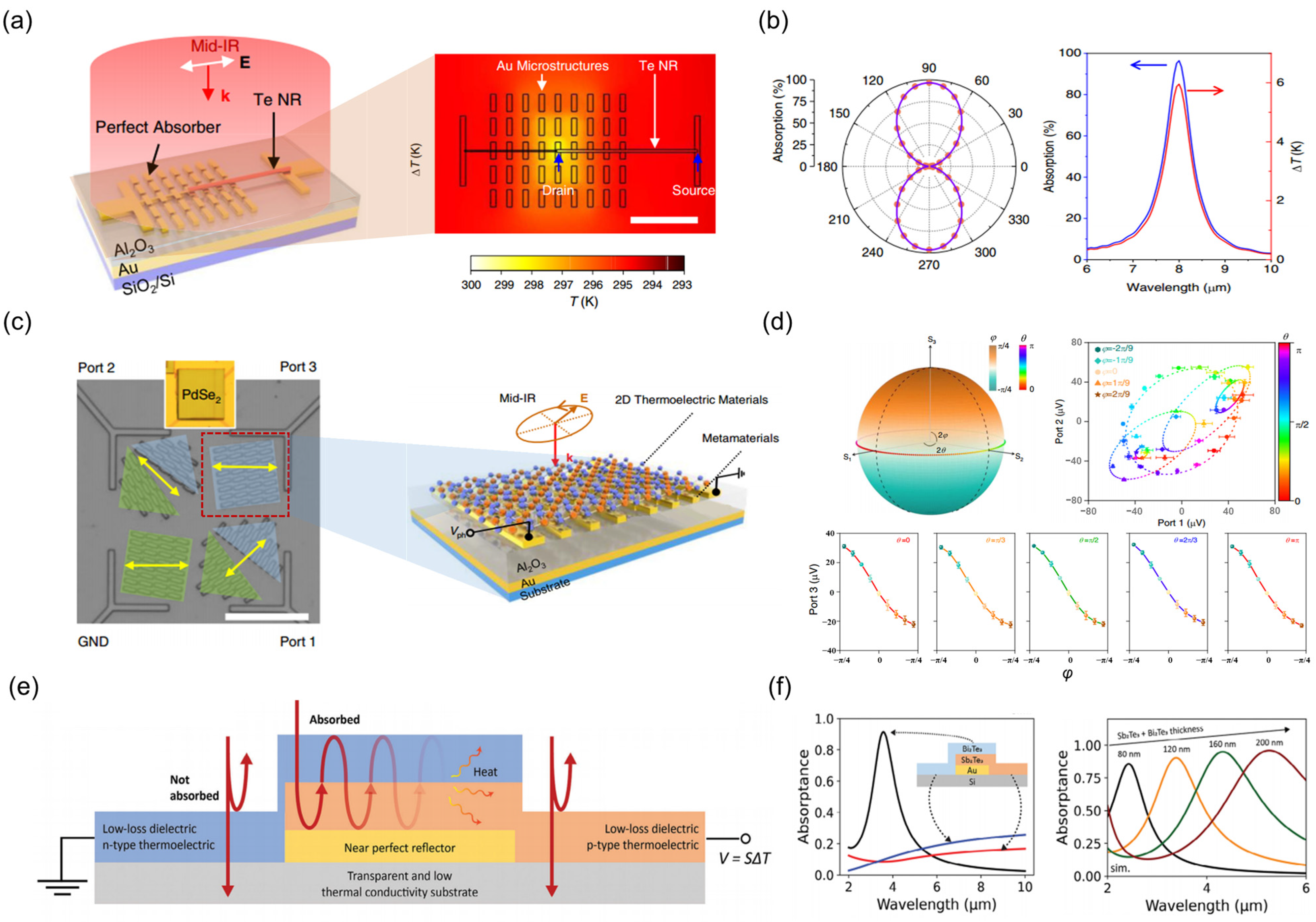
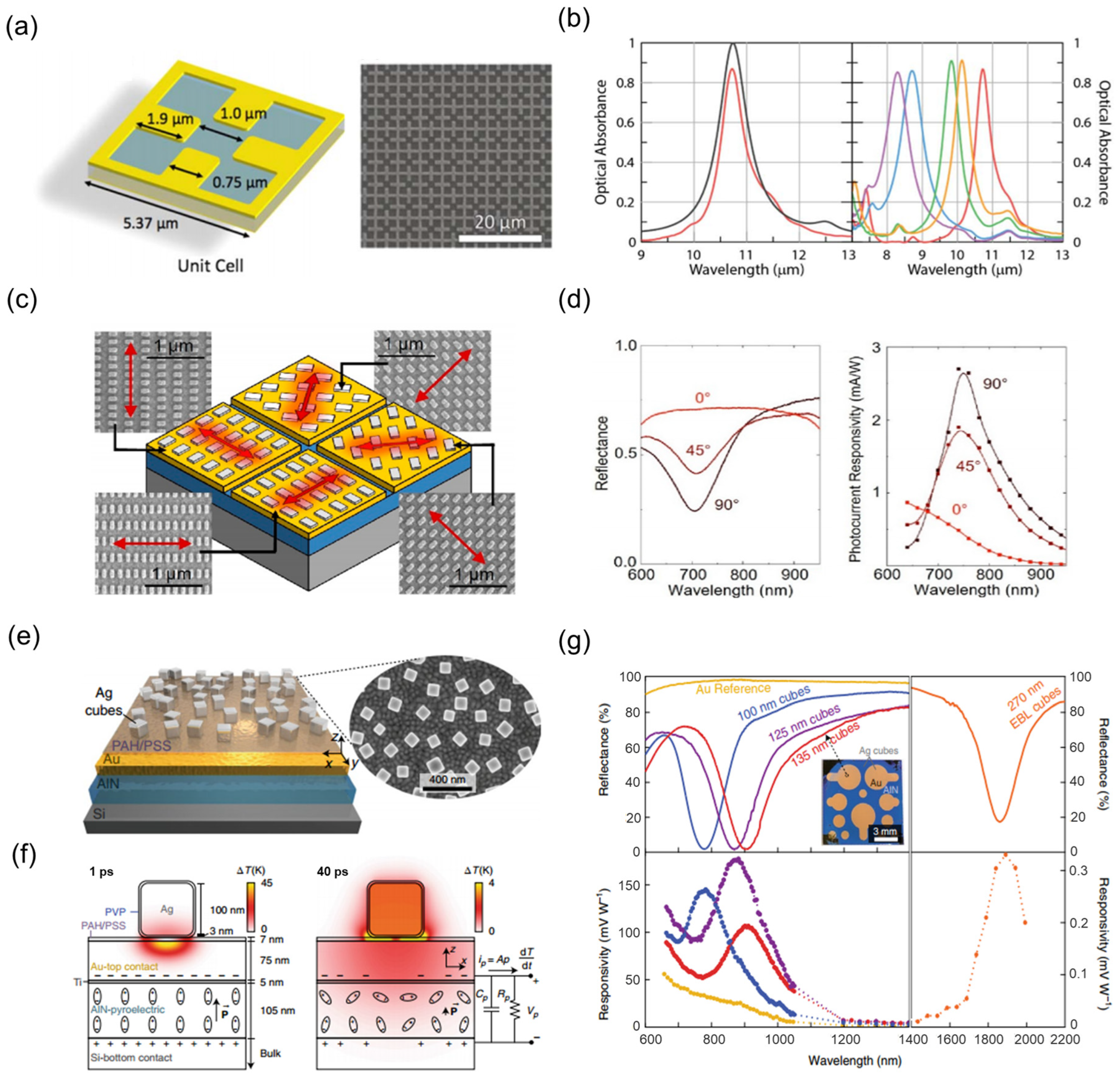
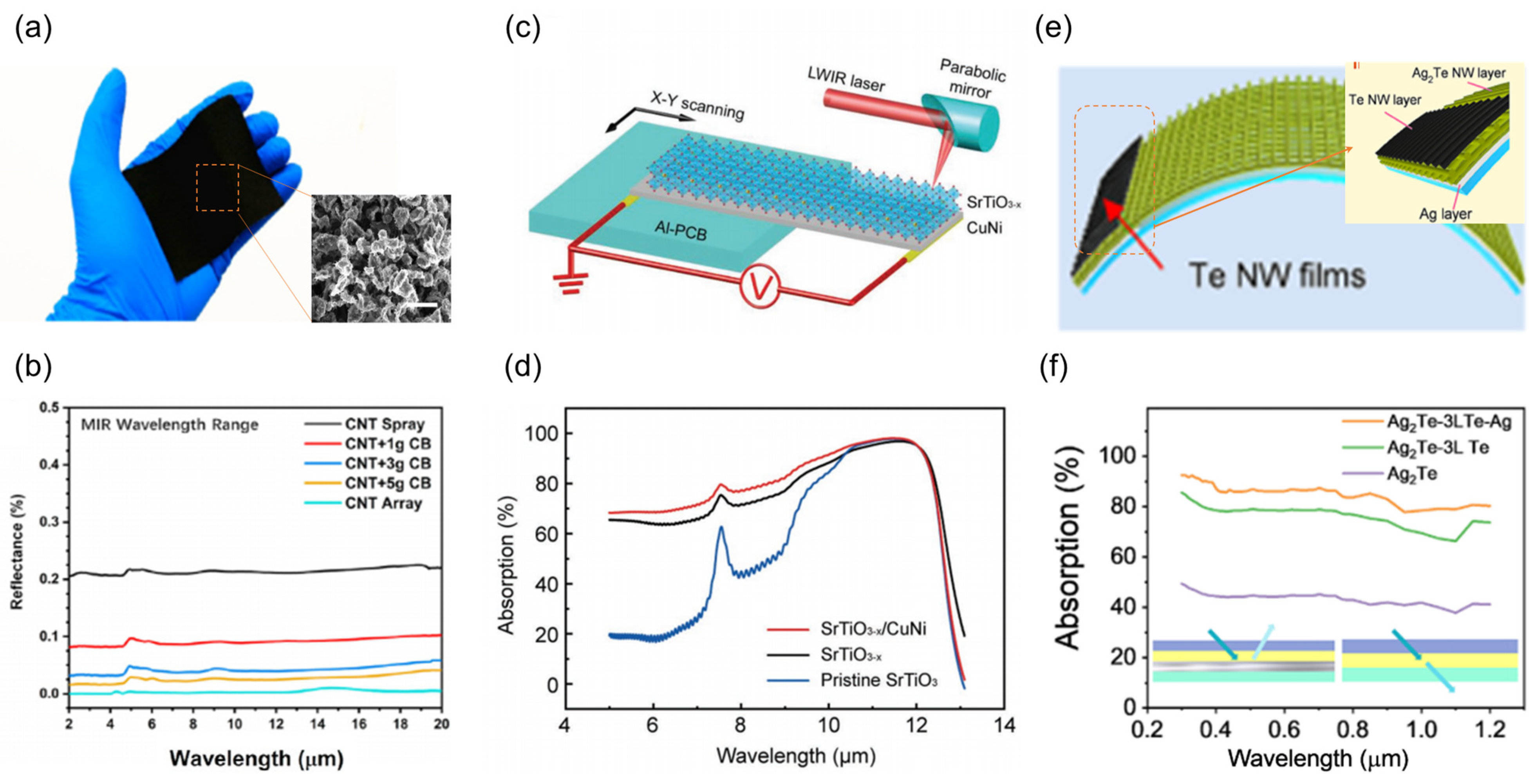
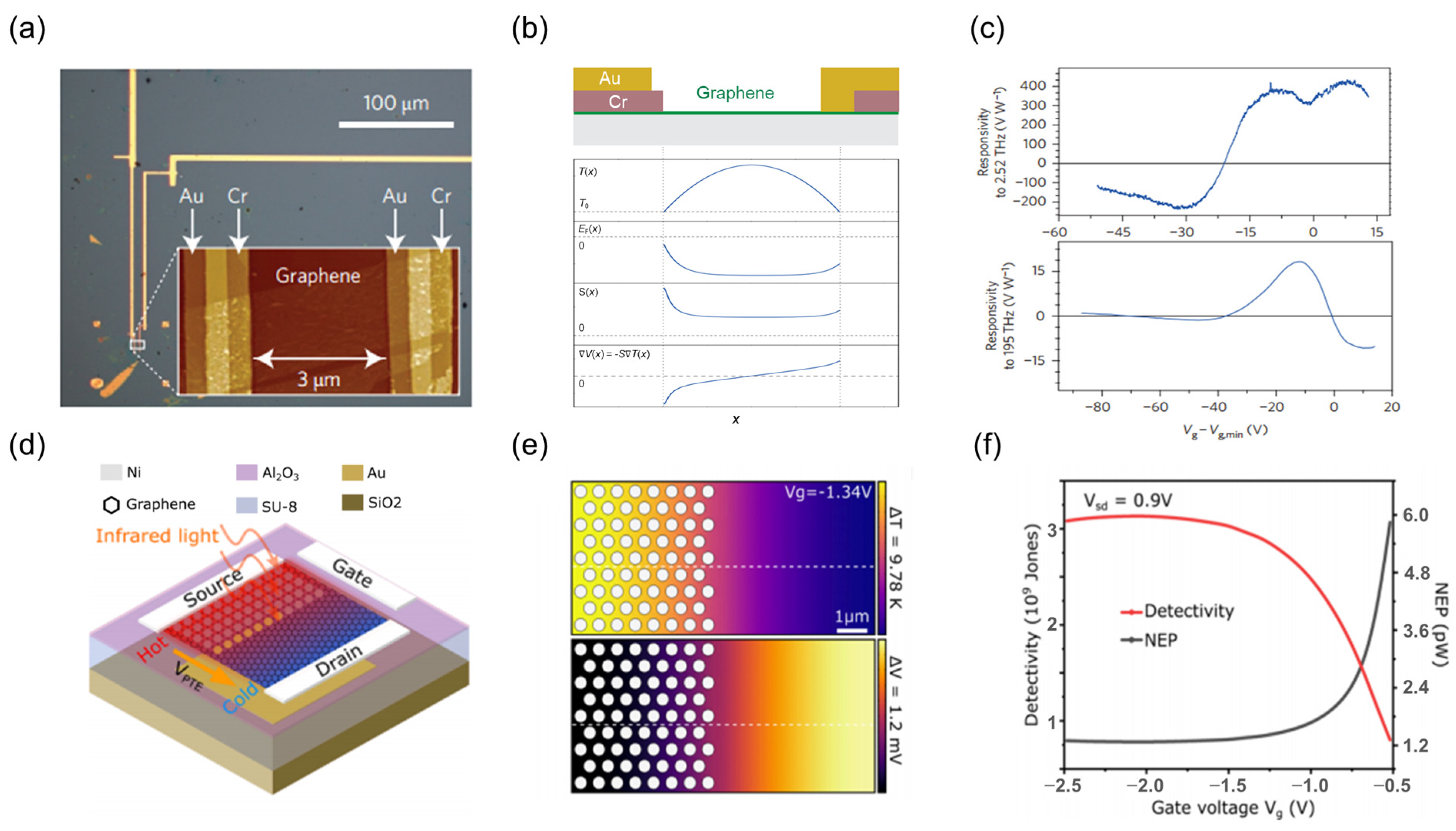
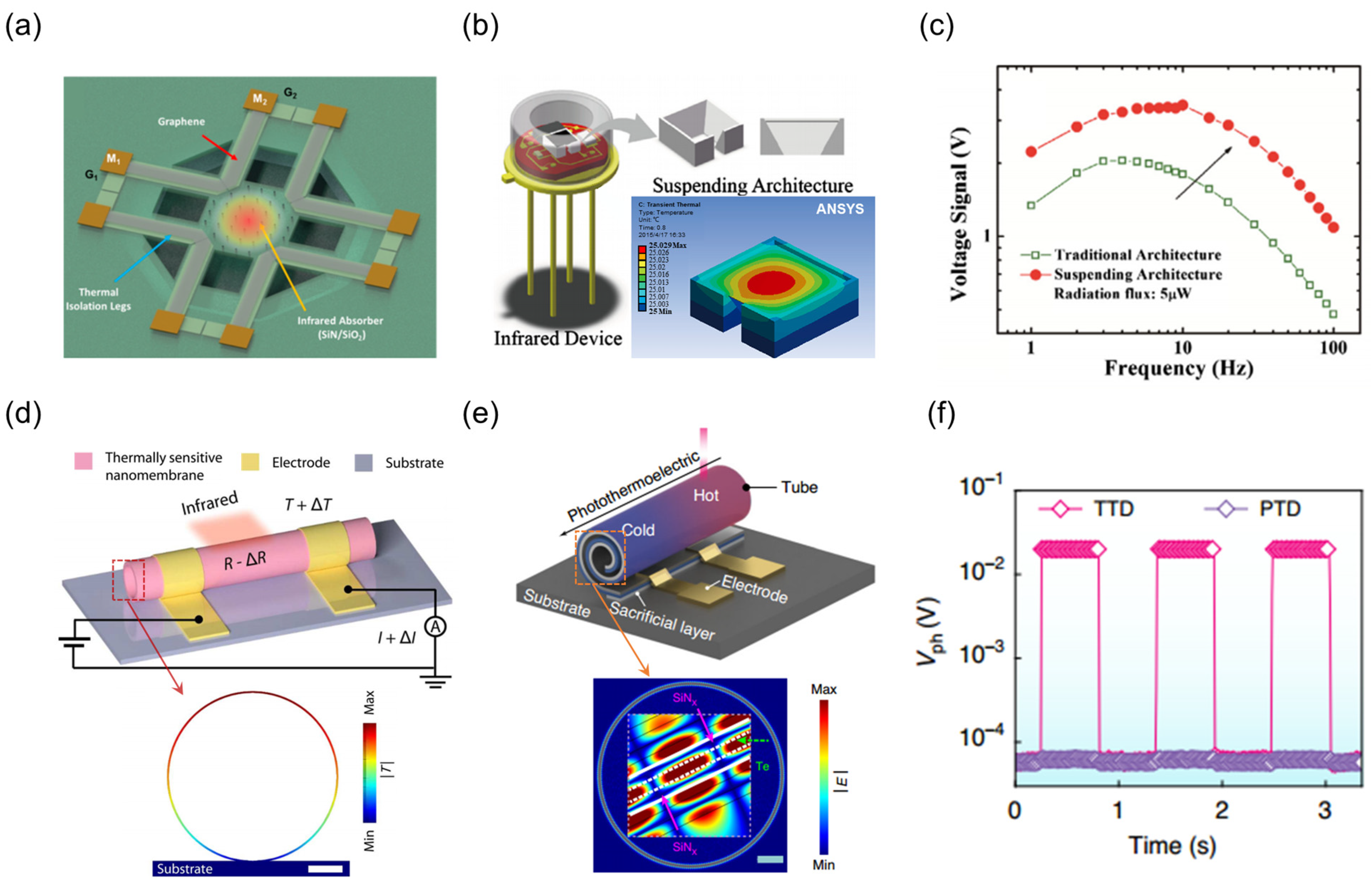
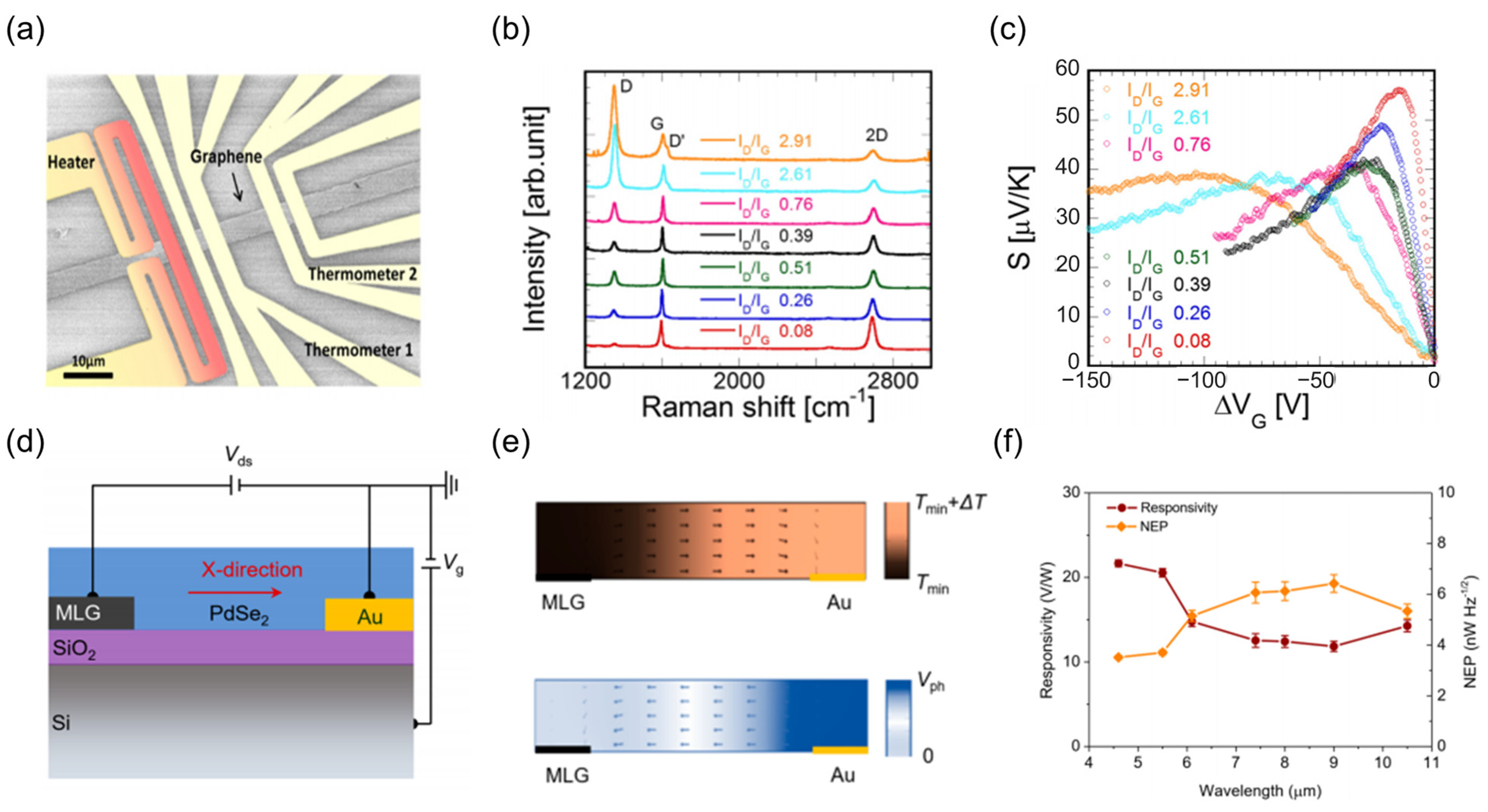
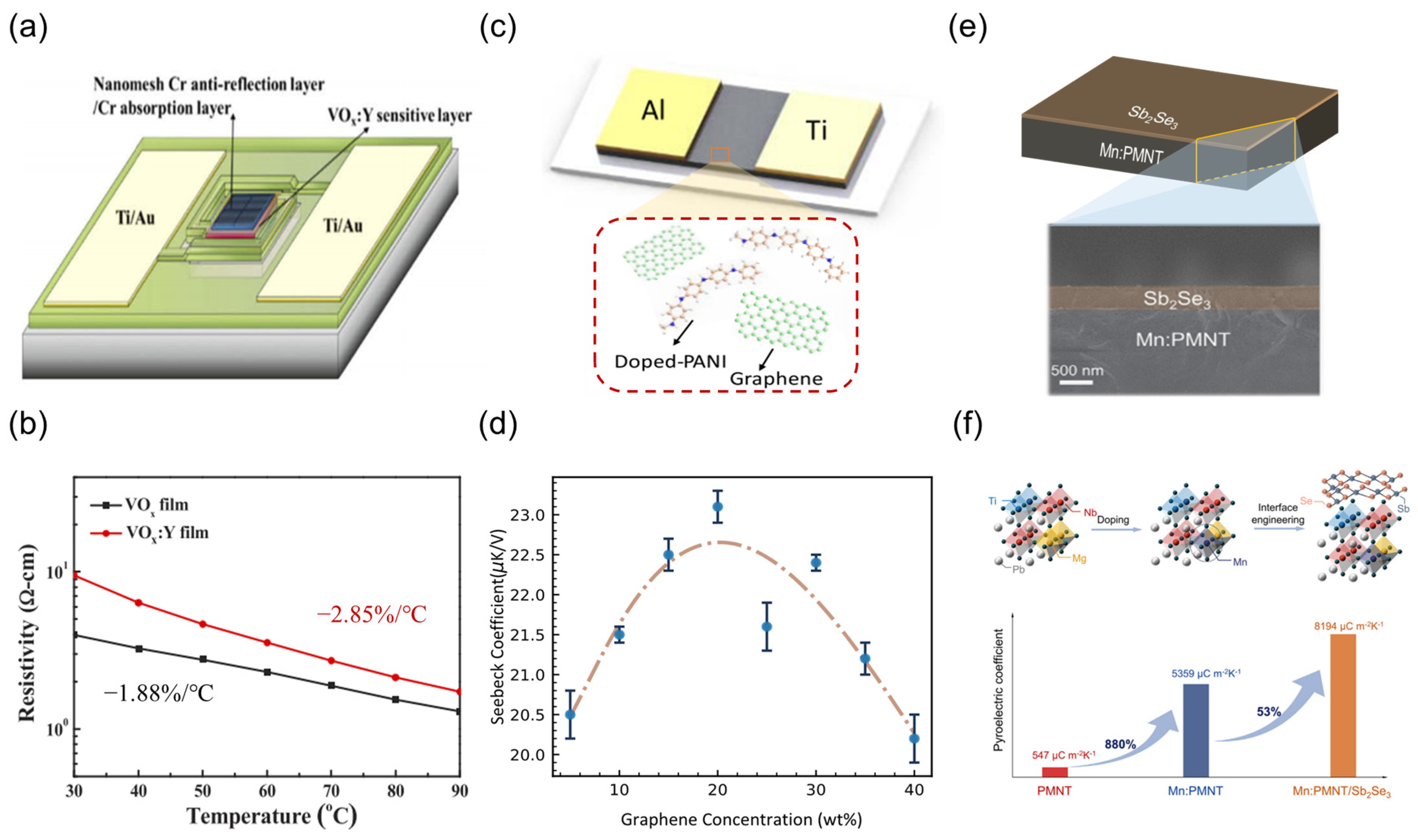

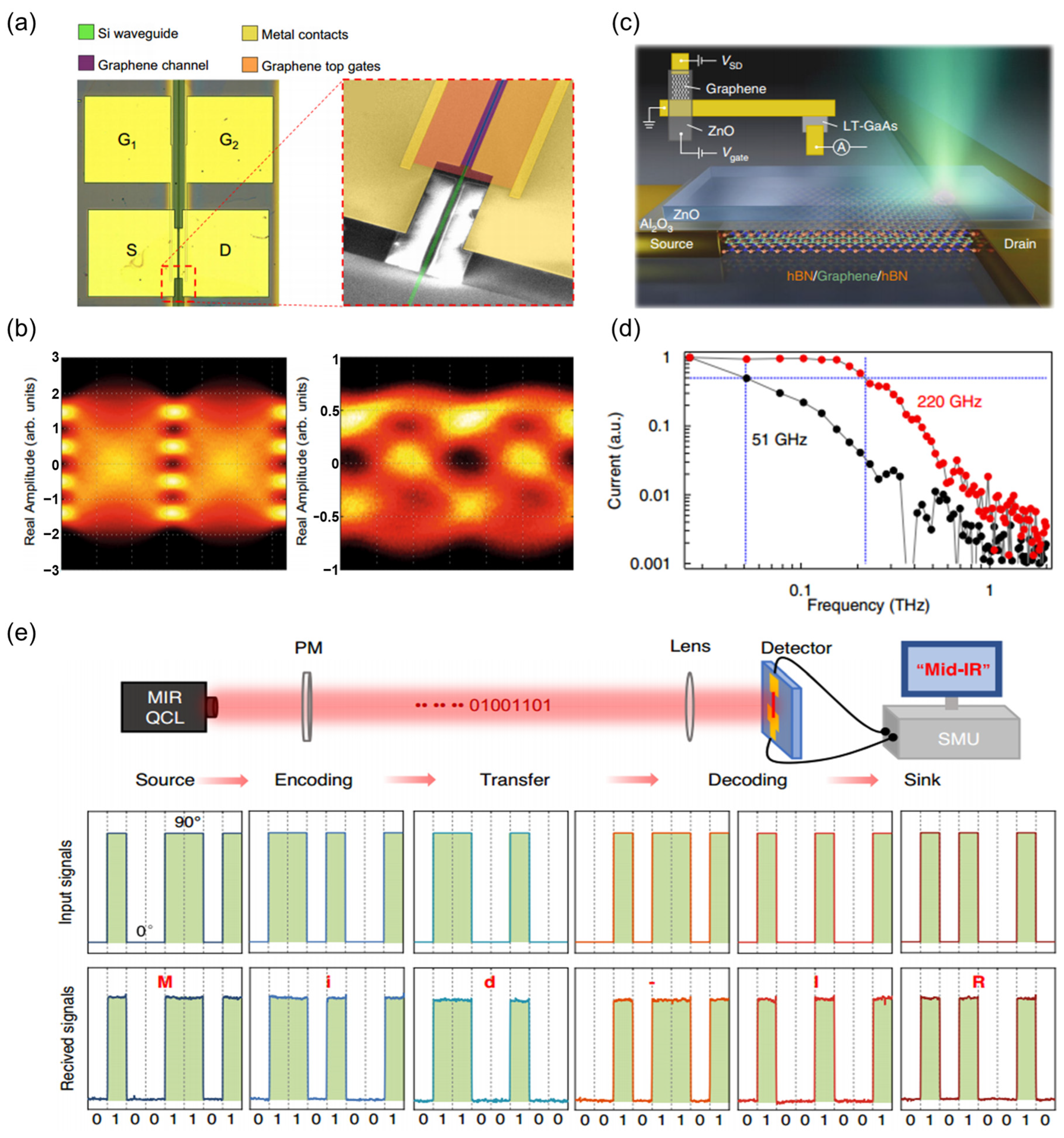
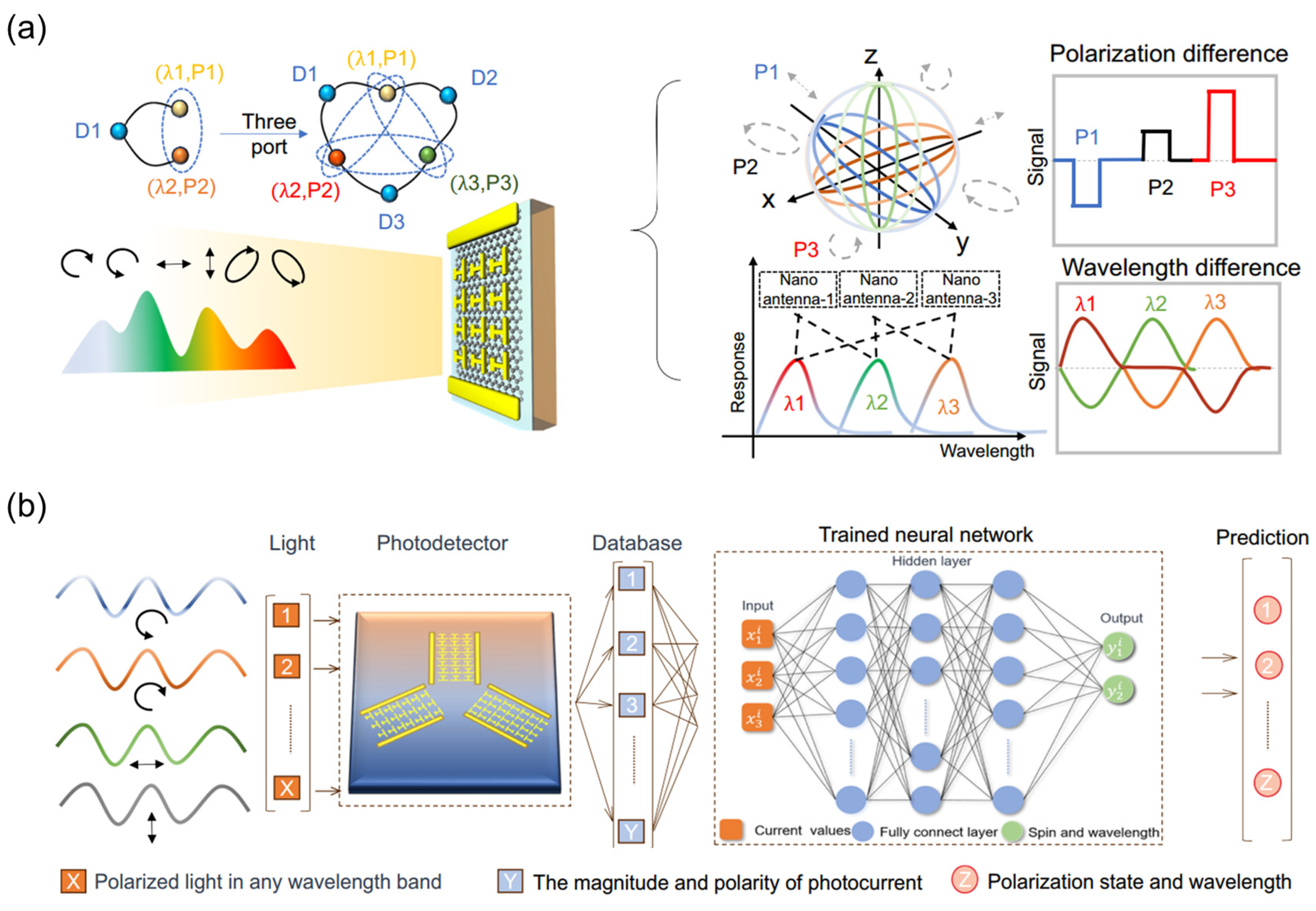
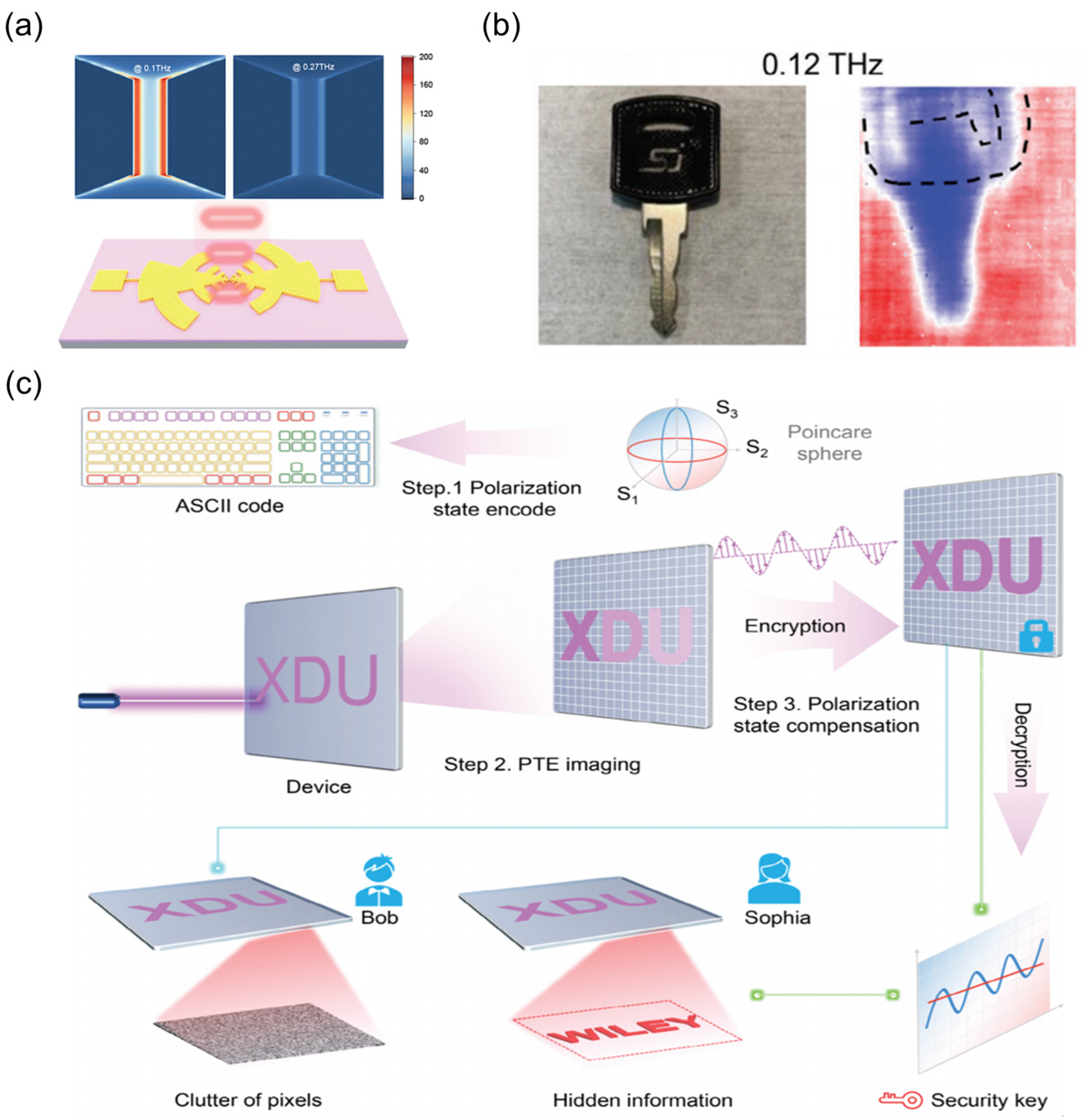

Disclaimer/Publisher’s Note: The statements, opinions and data contained in all publications are solely those of the individual author(s) and contributor(s) and not of MDPI and/or the editor(s). MDPI and/or the editor(s) disclaim responsibility for any injury to people or property resulting from any ideas, methods, instructions or products referred to in the content. |
© 2025 by the authors. Licensee MDPI, Basel, Switzerland. This article is an open access article distributed under the terms and conditions of the Creative Commons Attribution (CC BY) license (https://creativecommons.org/licenses/by/4.0/).
Share and Cite
Peng, Y.; Liu, J.; Fu, J.; Luo, Y.; Zhao, X.; Wei, X. Emerging Thermal Detectors Based on Low-Dimensional Materials: Strategies and Progress. Nanomaterials 2025, 15, 459. https://doi.org/10.3390/nano15060459
Peng Y, Liu J, Fu J, Luo Y, Zhao X, Wei X. Emerging Thermal Detectors Based on Low-Dimensional Materials: Strategies and Progress. Nanomaterials. 2025; 15(6):459. https://doi.org/10.3390/nano15060459
Chicago/Turabian StylePeng, Yang, Jun Liu, Jintao Fu, Ying Luo, Xiangrui Zhao, and Xingzhan Wei. 2025. "Emerging Thermal Detectors Based on Low-Dimensional Materials: Strategies and Progress" Nanomaterials 15, no. 6: 459. https://doi.org/10.3390/nano15060459
APA StylePeng, Y., Liu, J., Fu, J., Luo, Y., Zhao, X., & Wei, X. (2025). Emerging Thermal Detectors Based on Low-Dimensional Materials: Strategies and Progress. Nanomaterials, 15(6), 459. https://doi.org/10.3390/nano15060459





